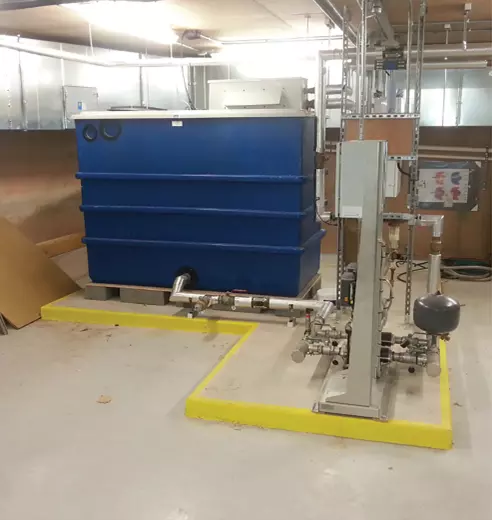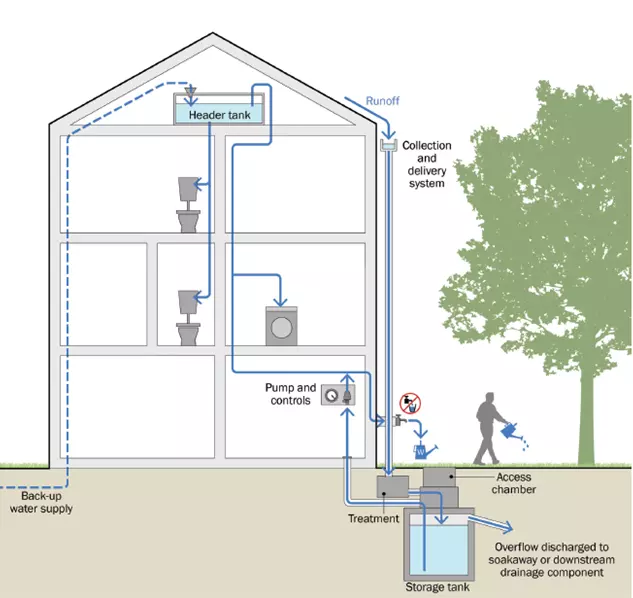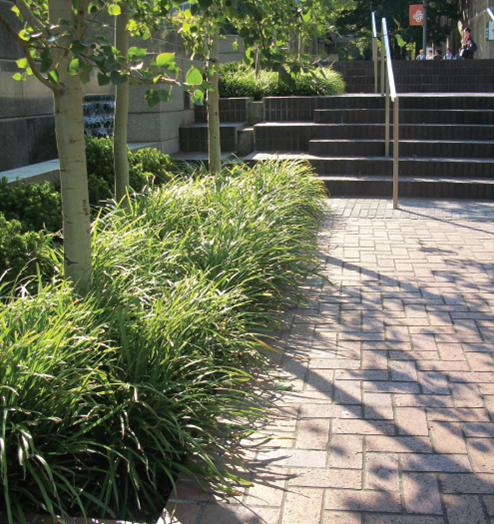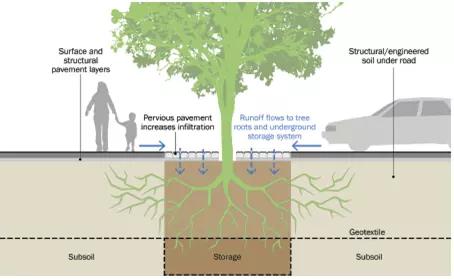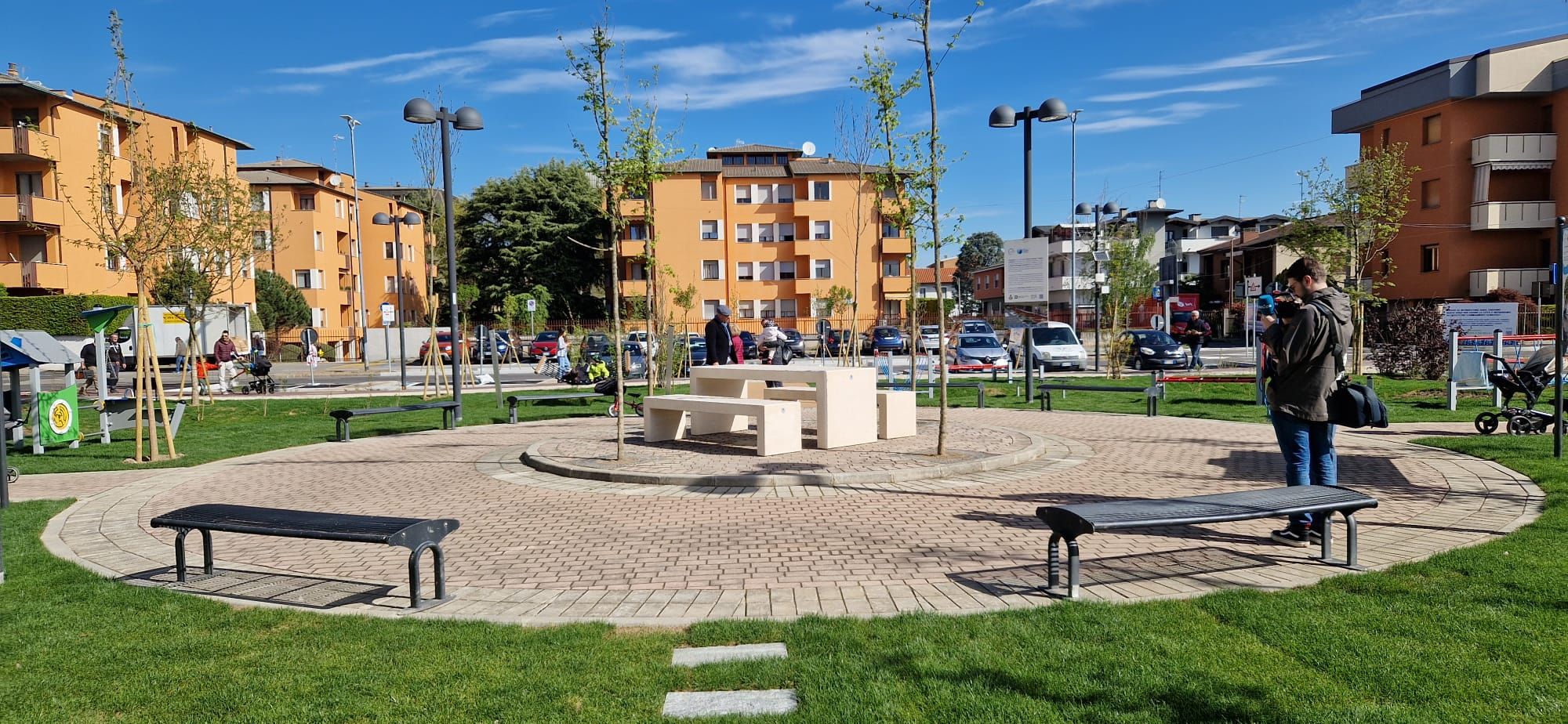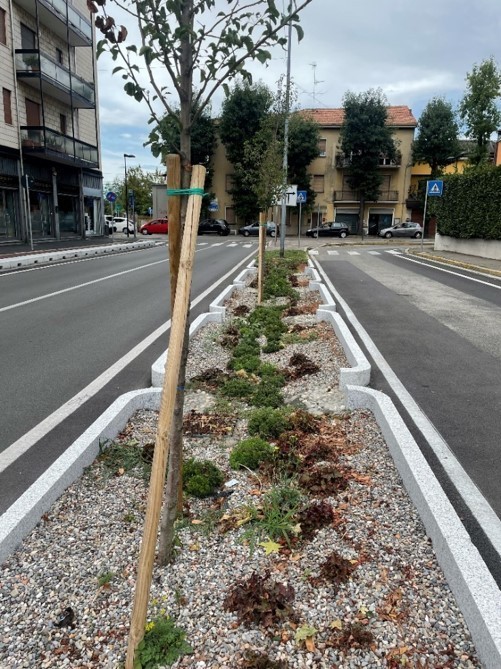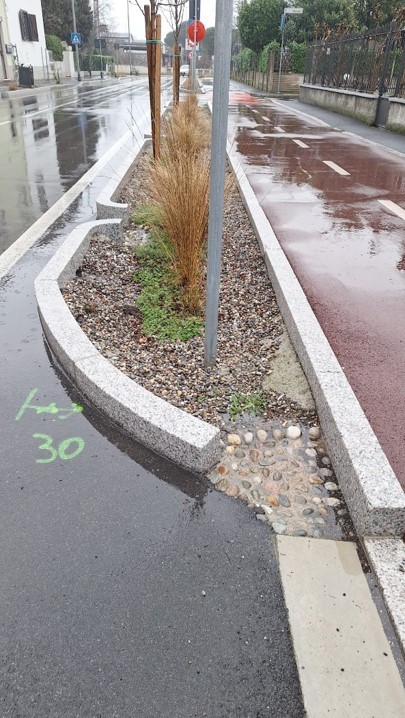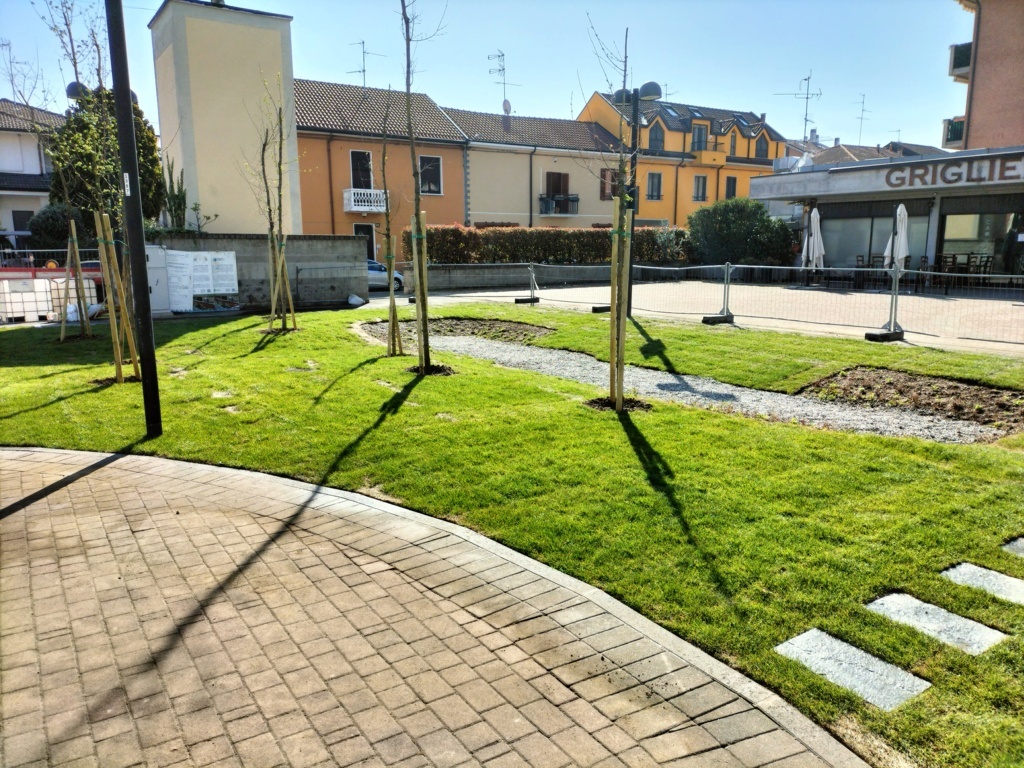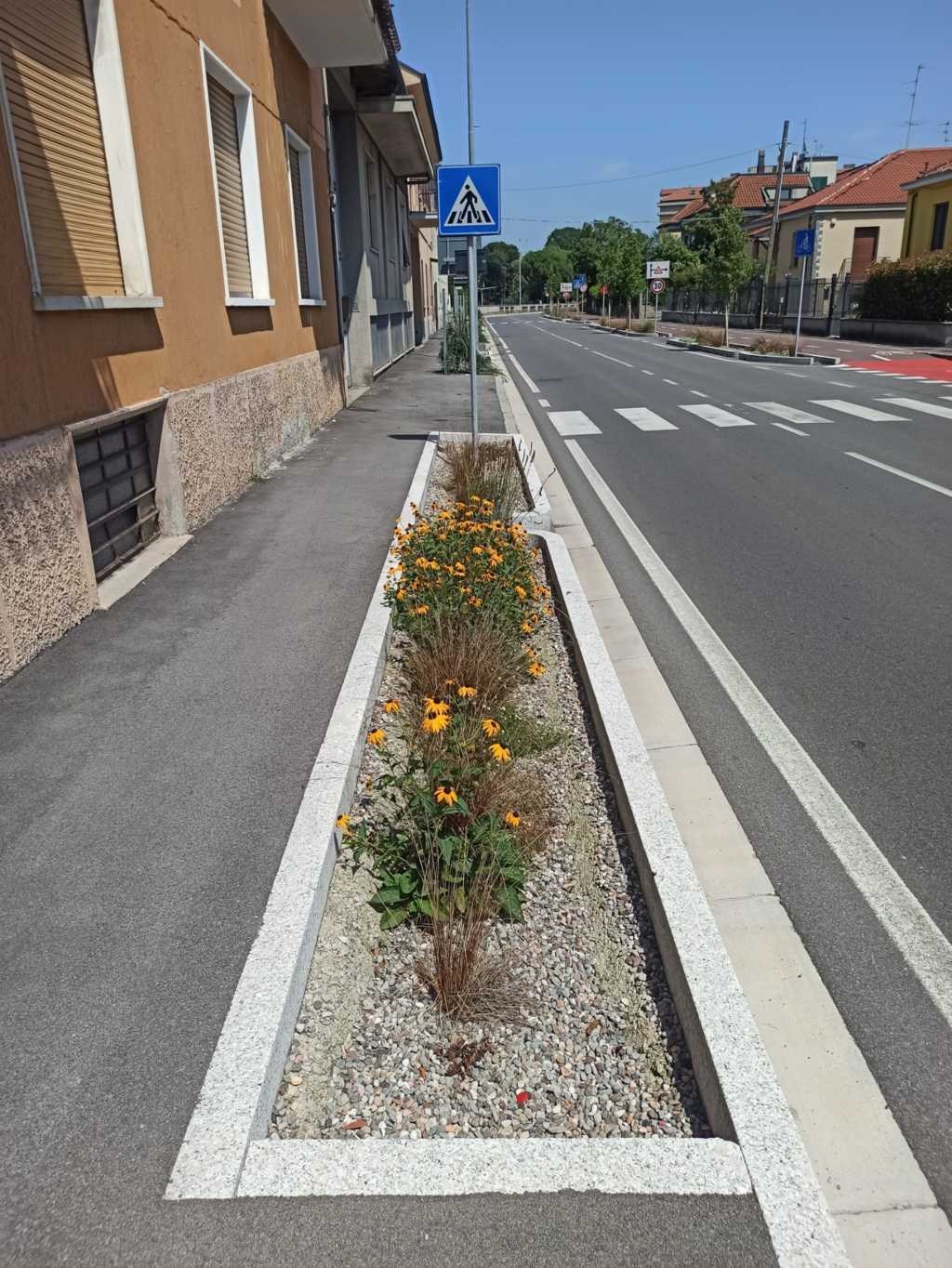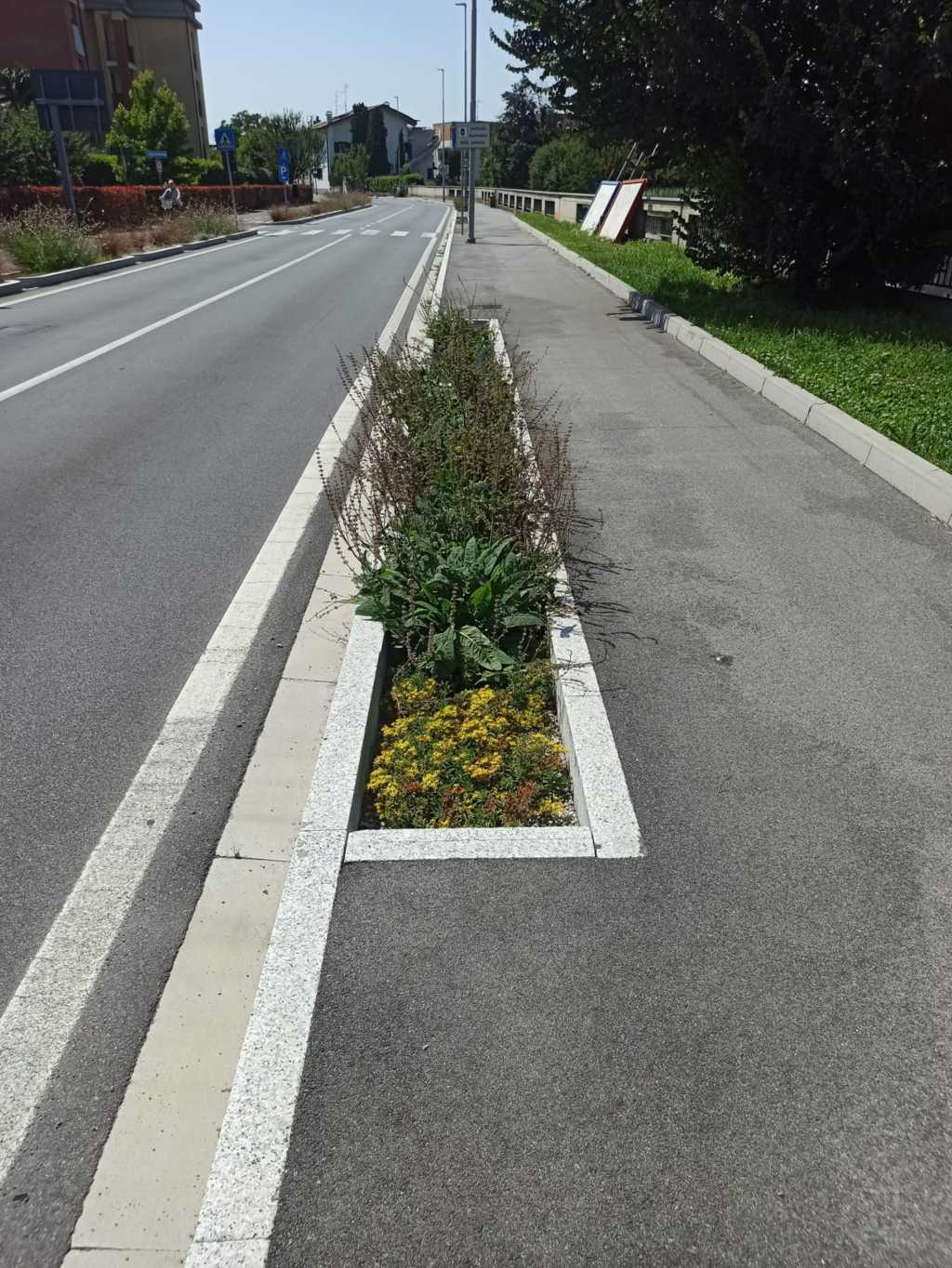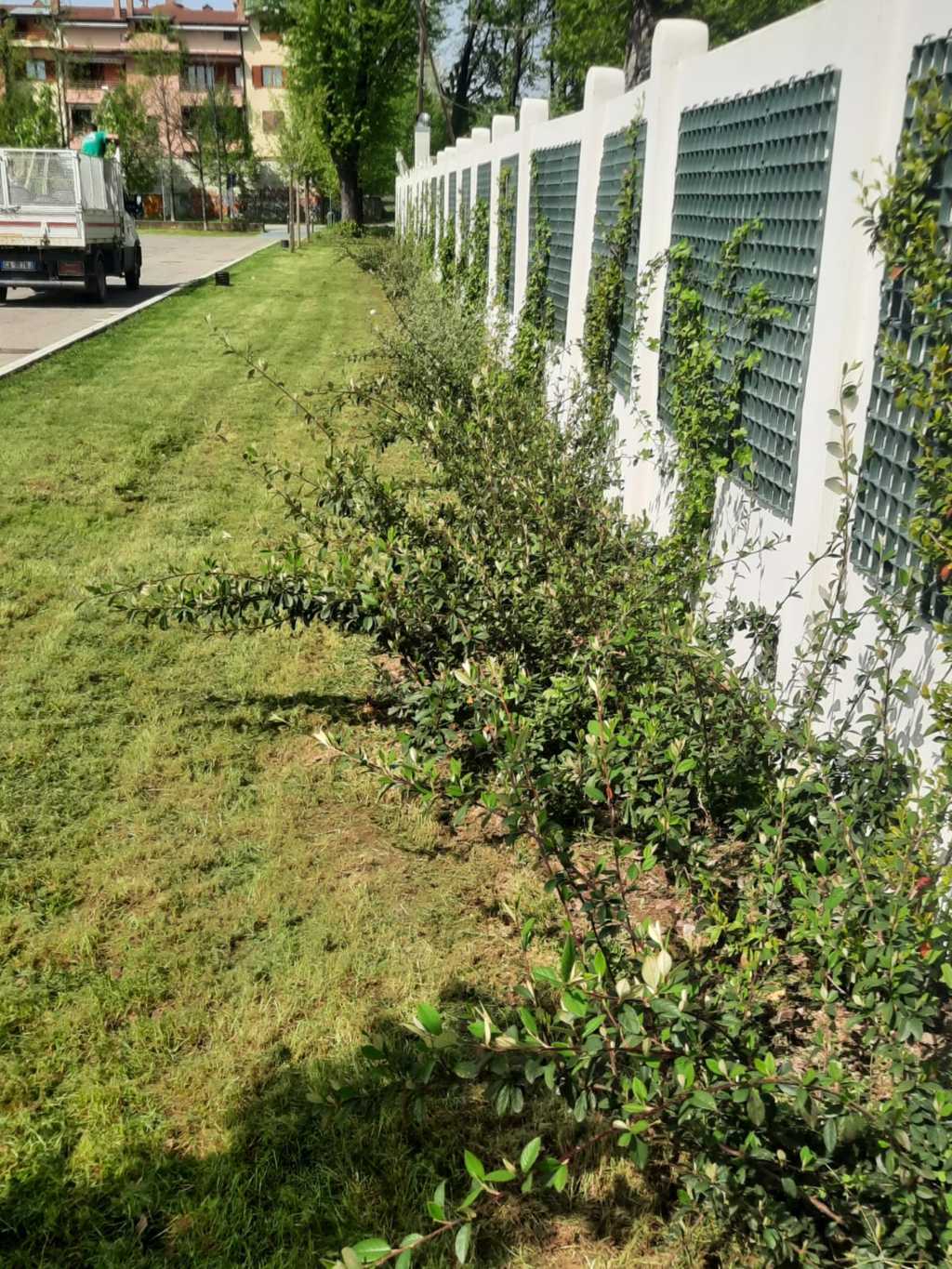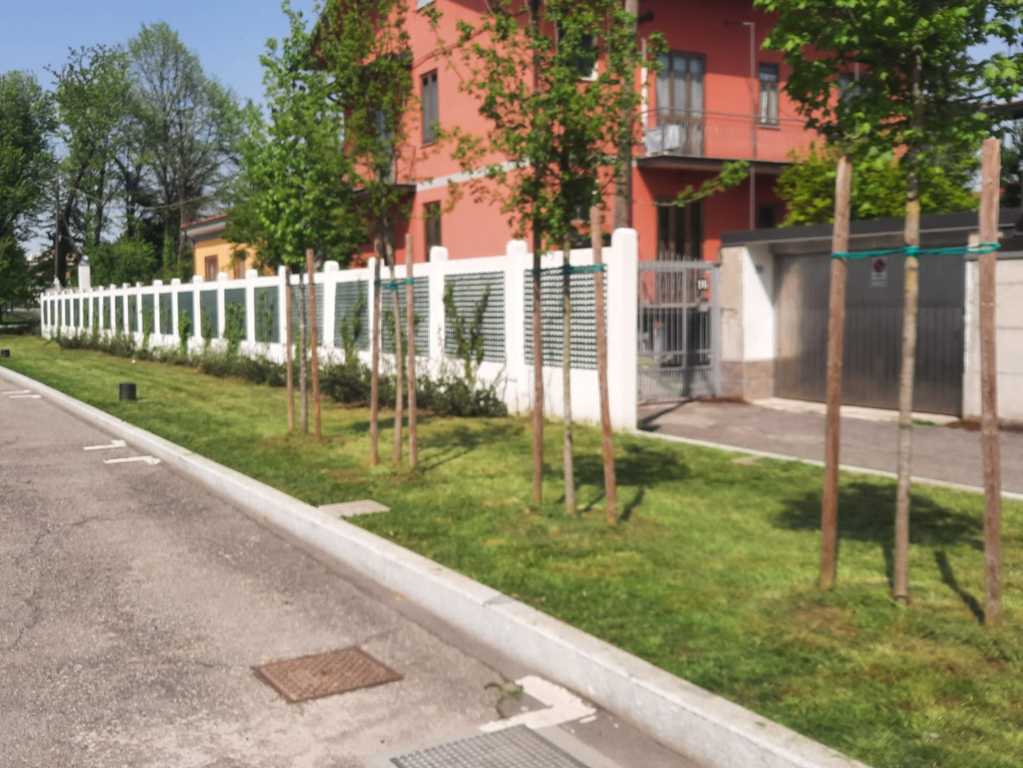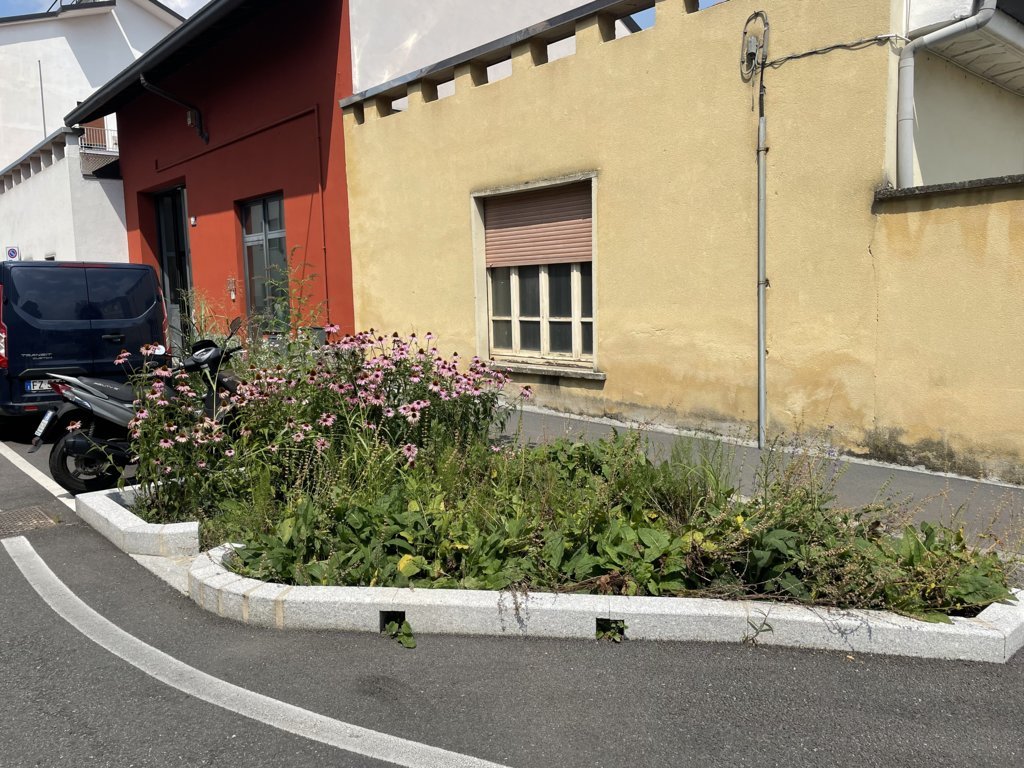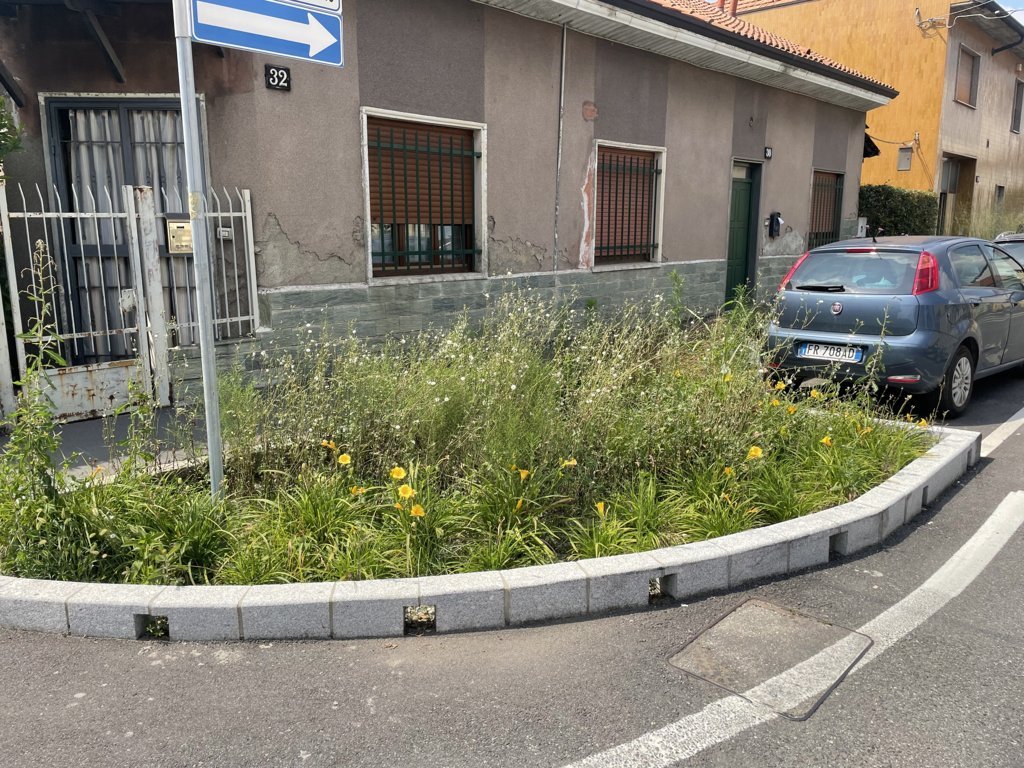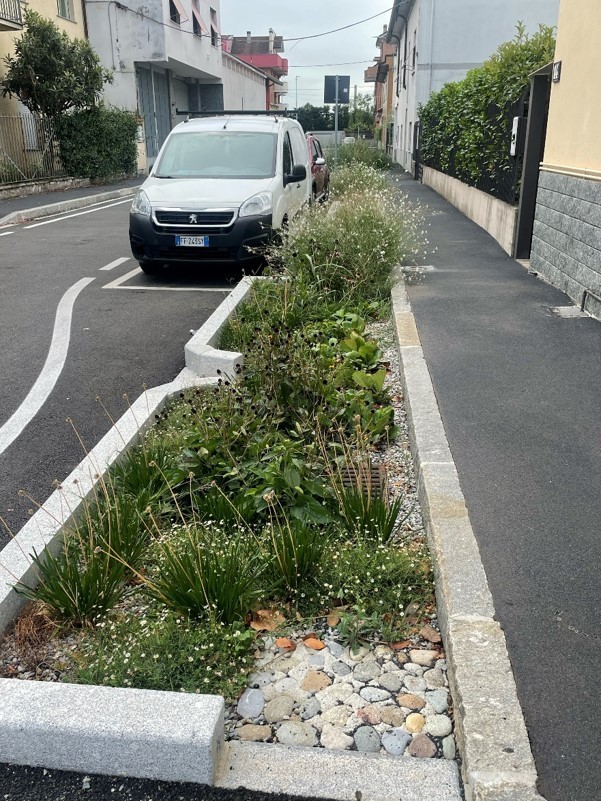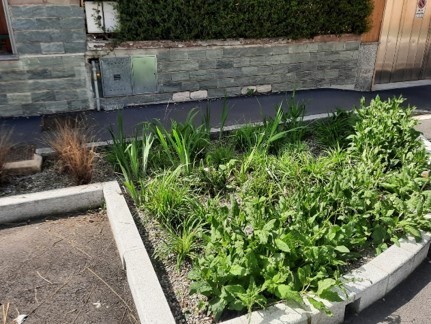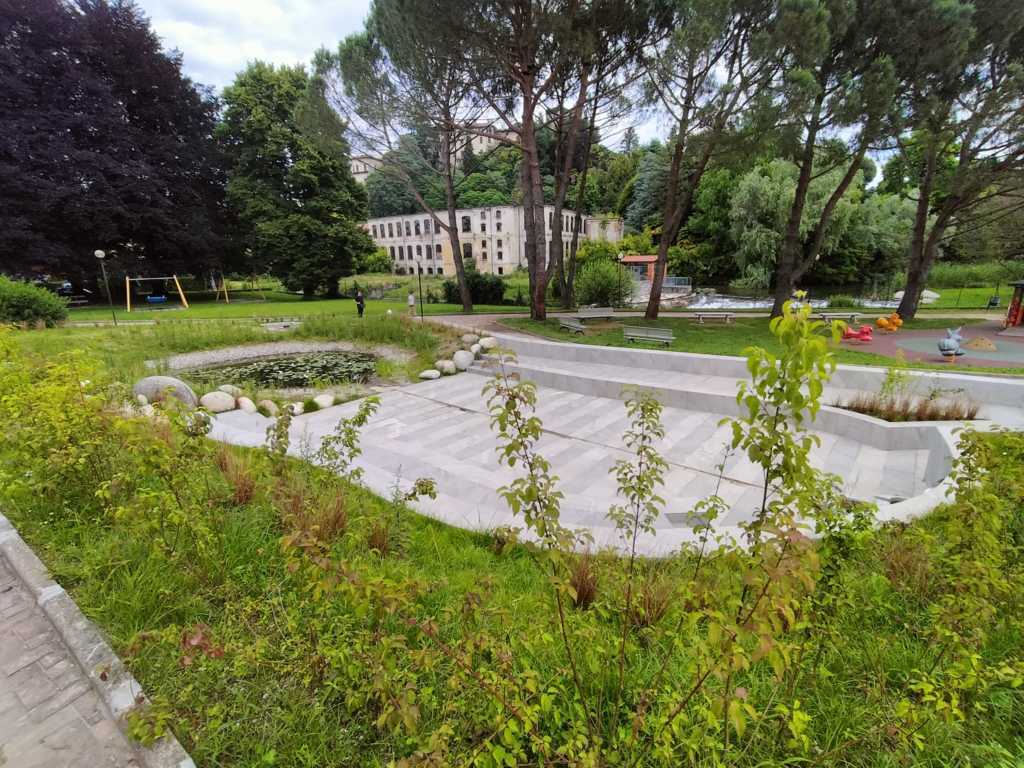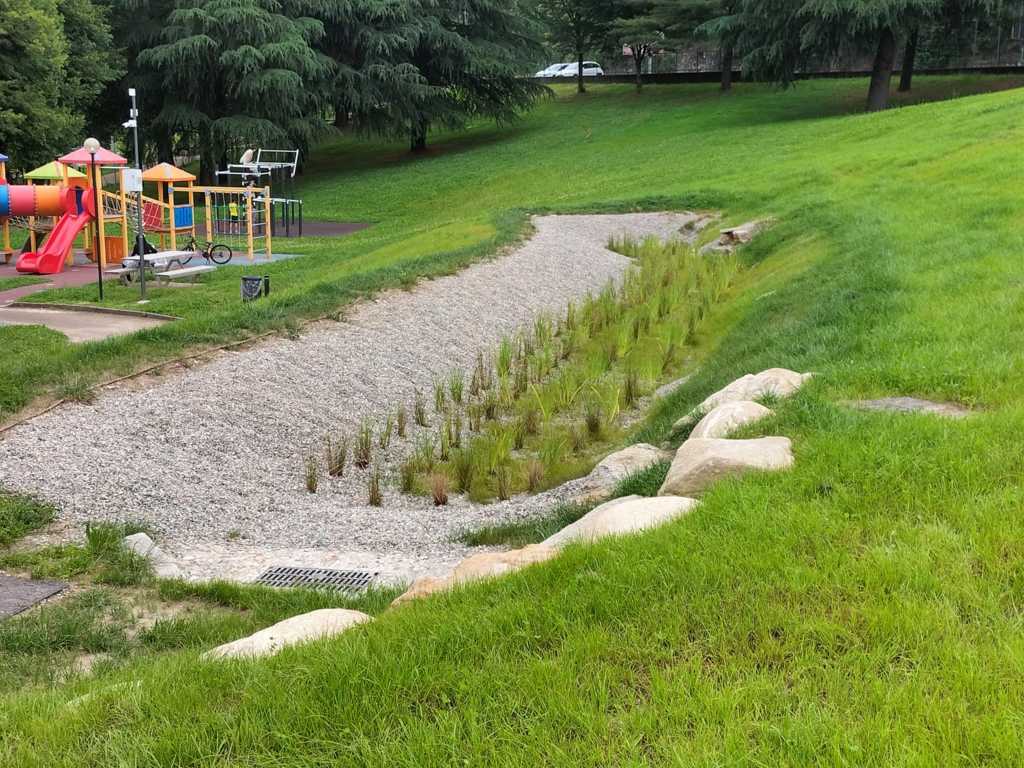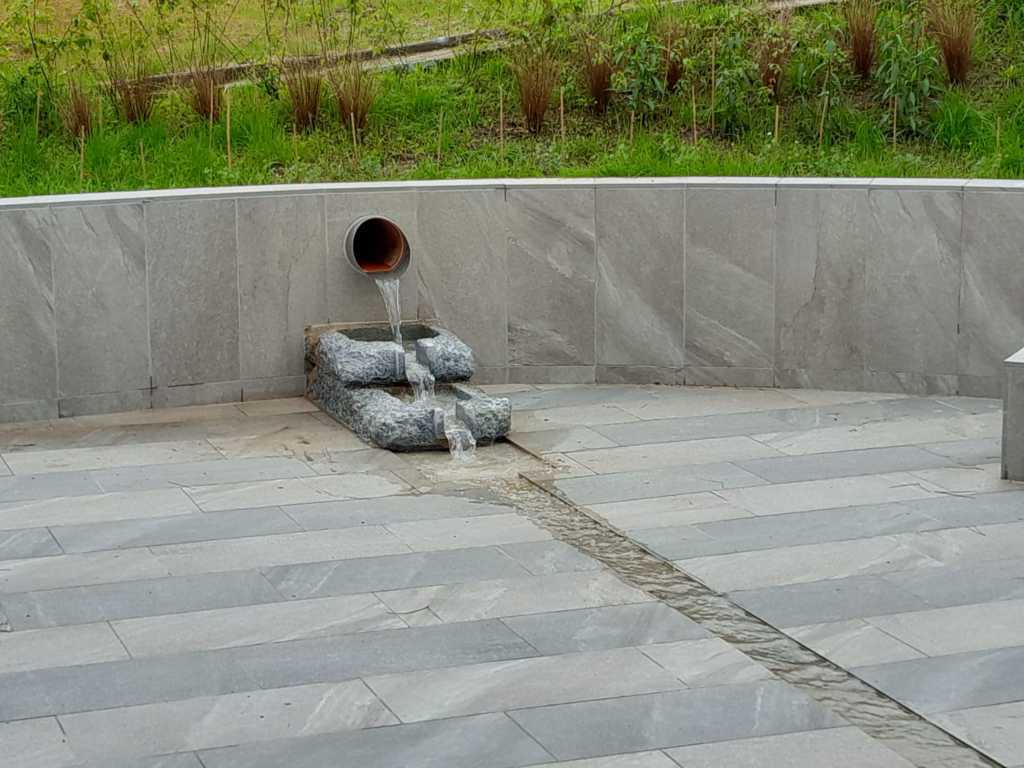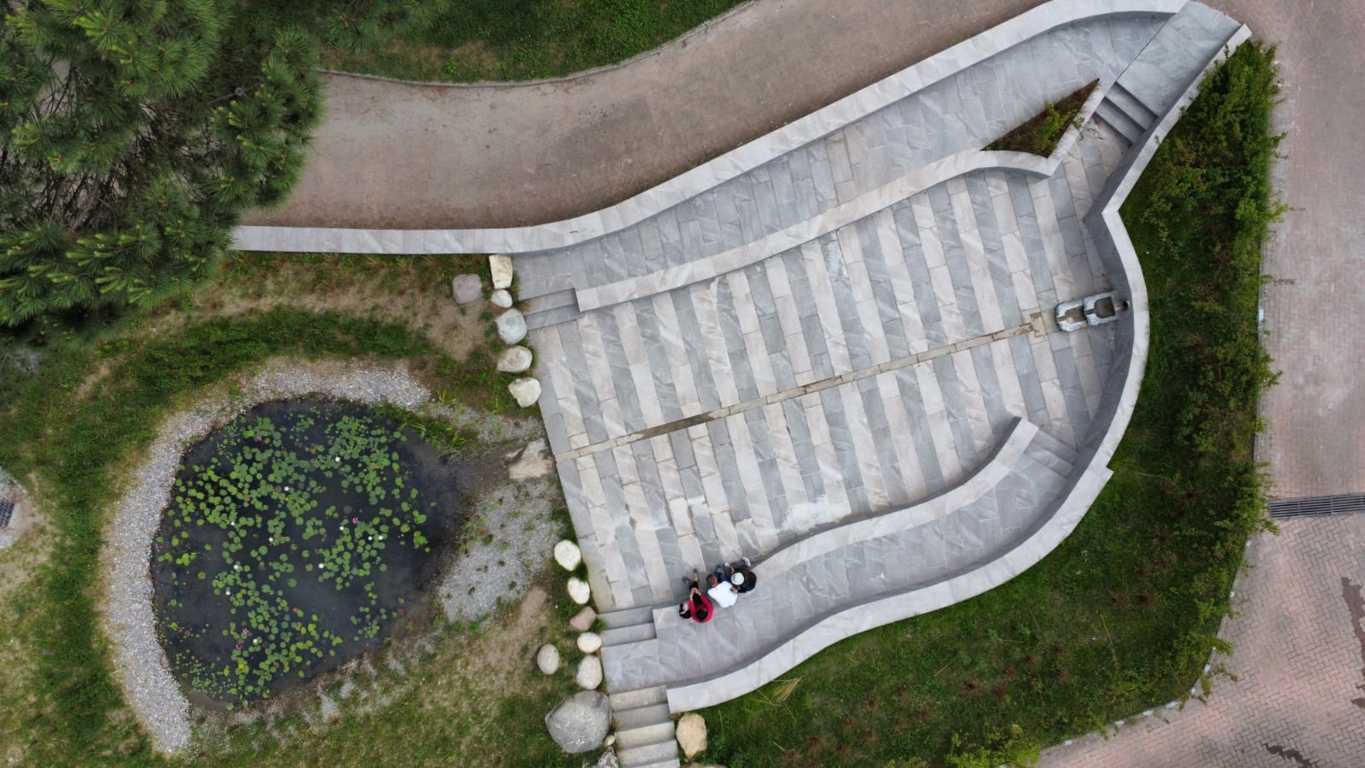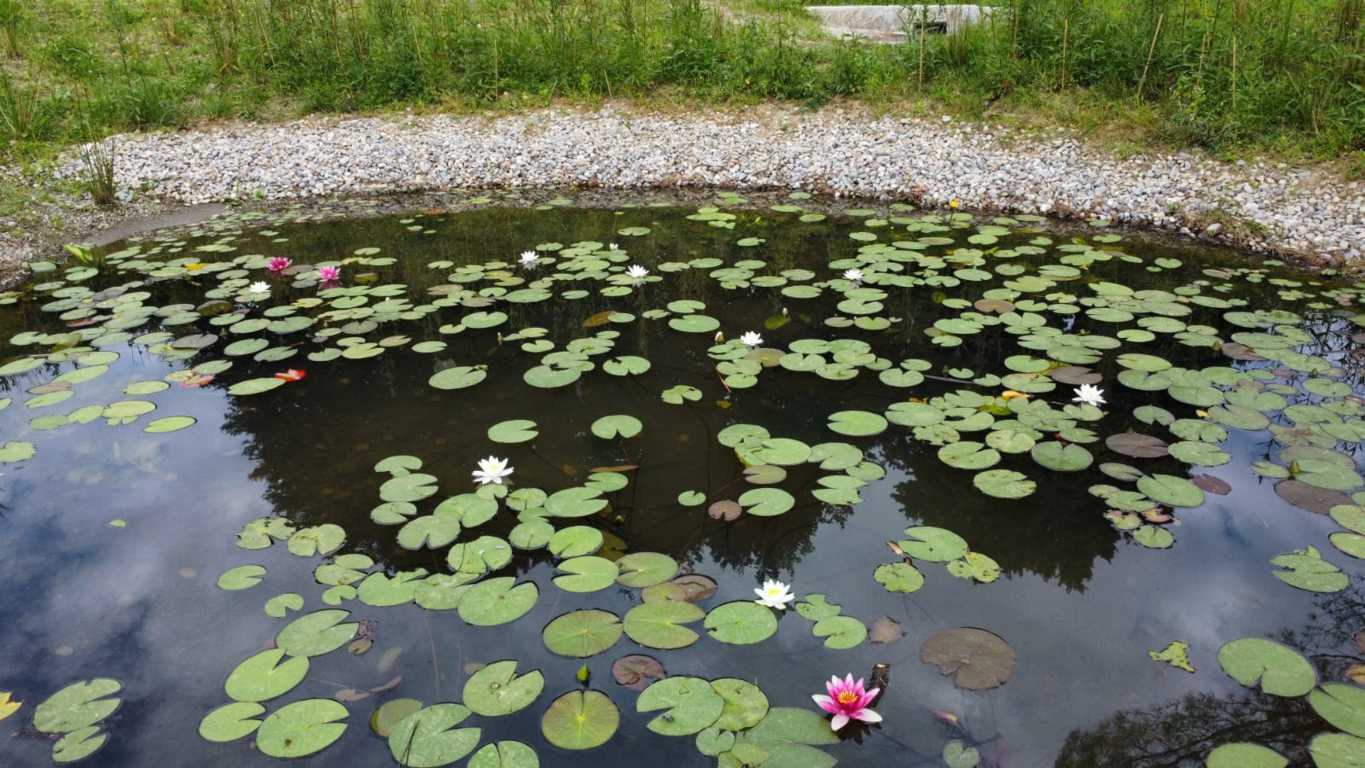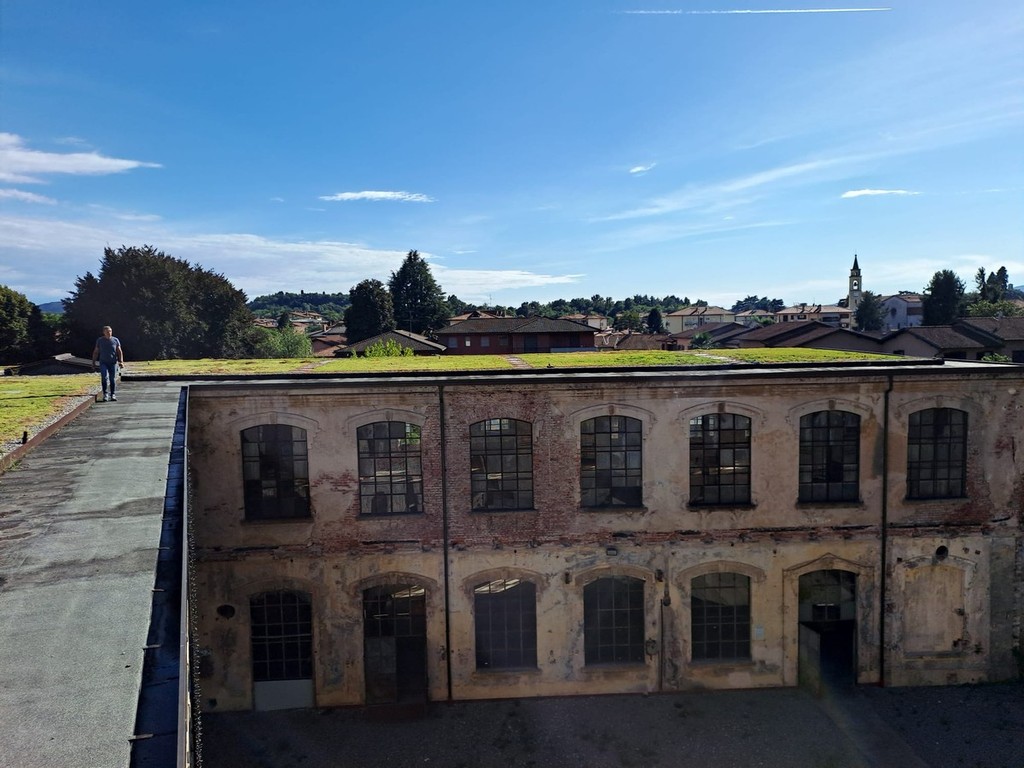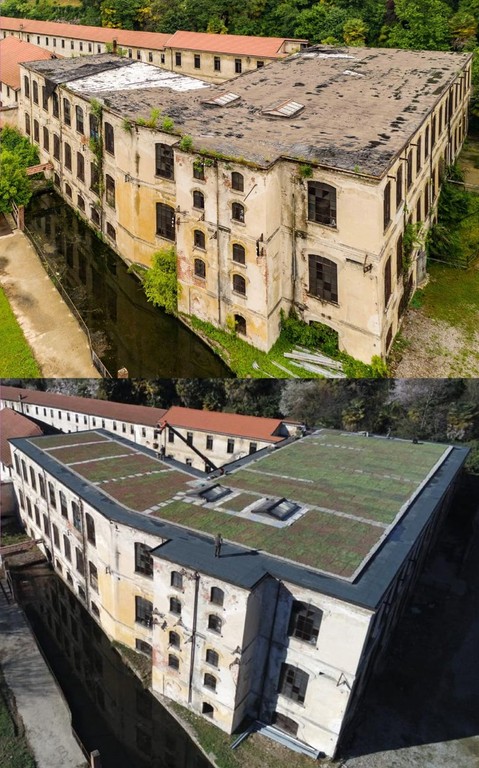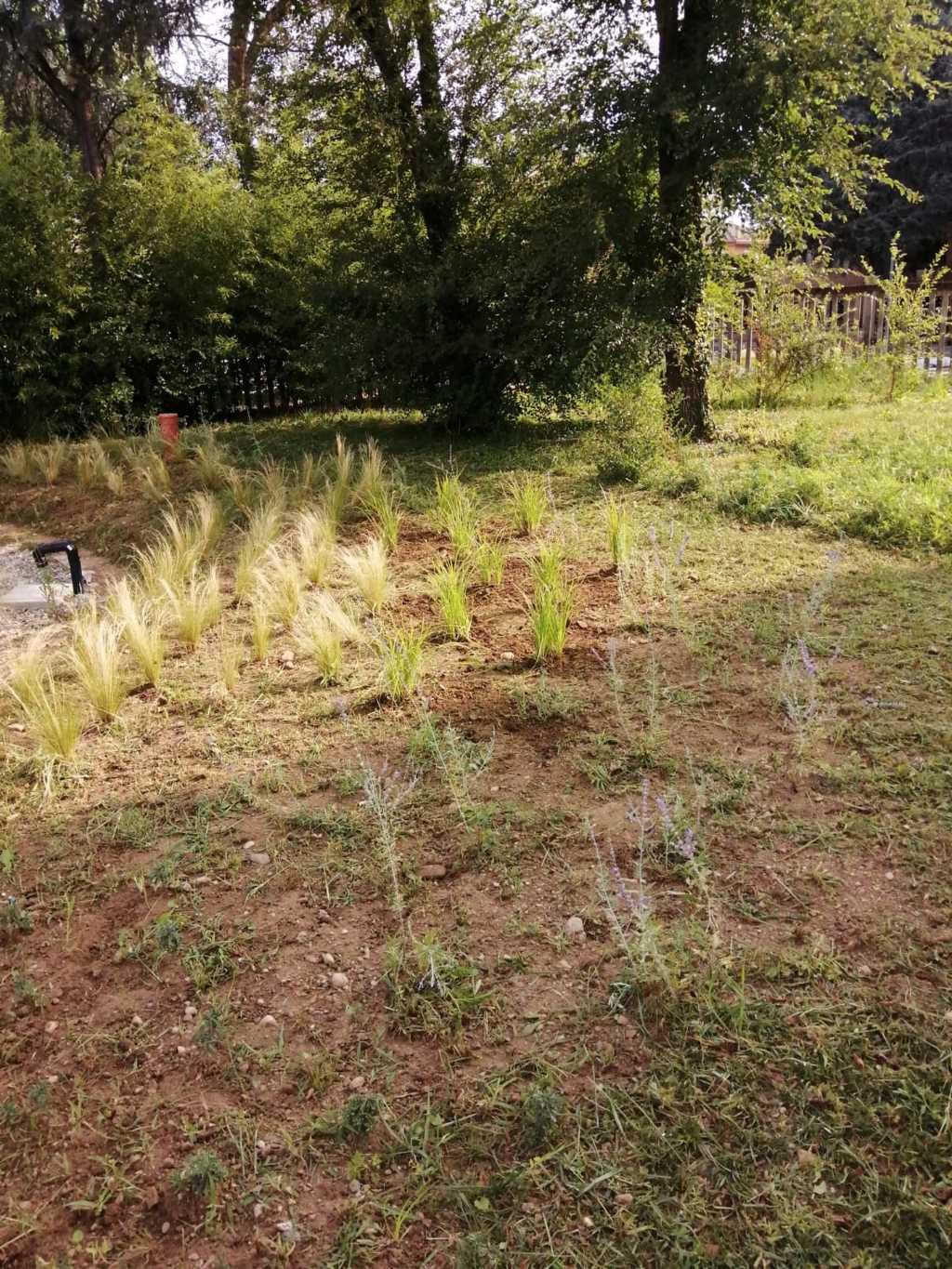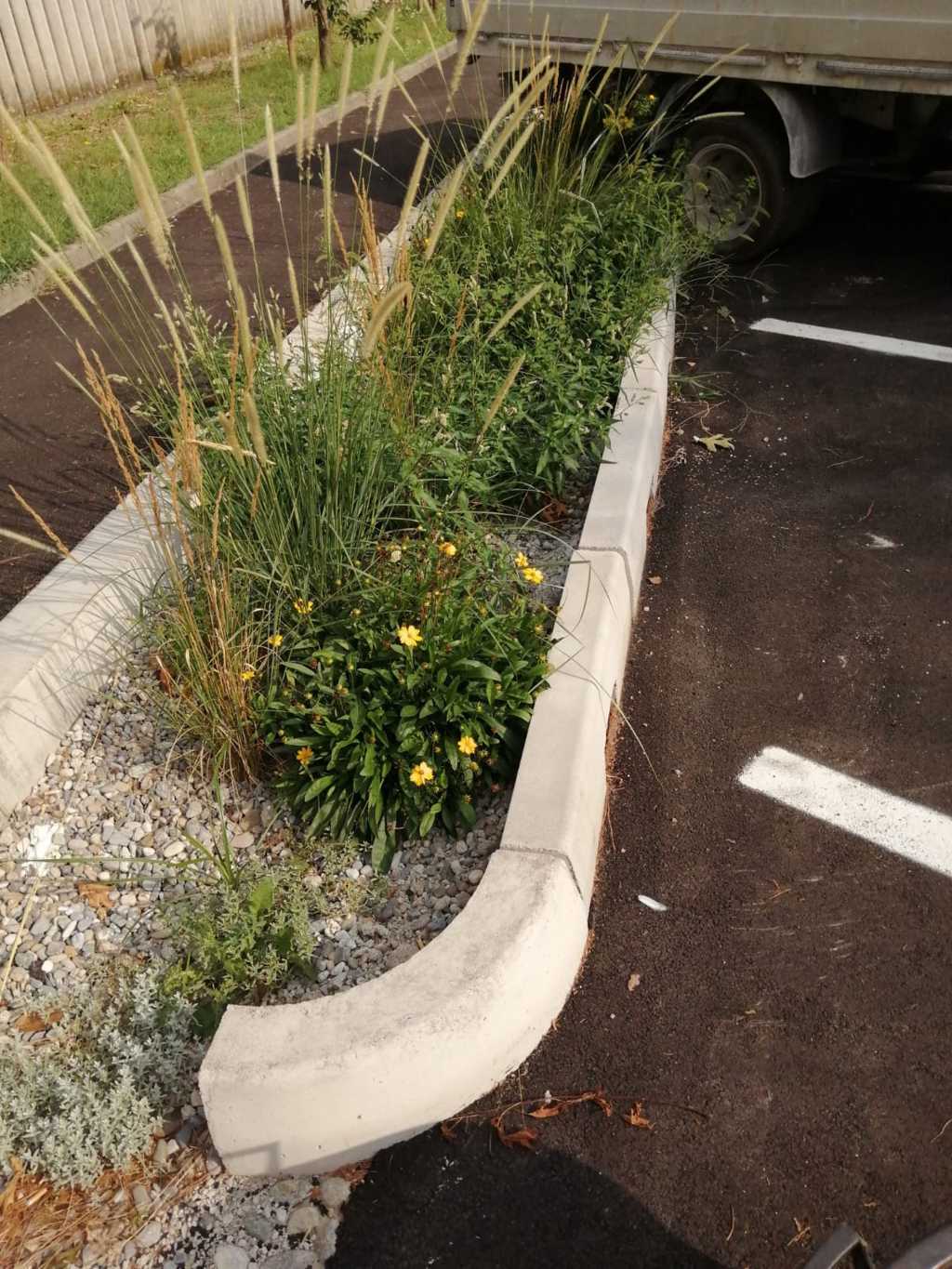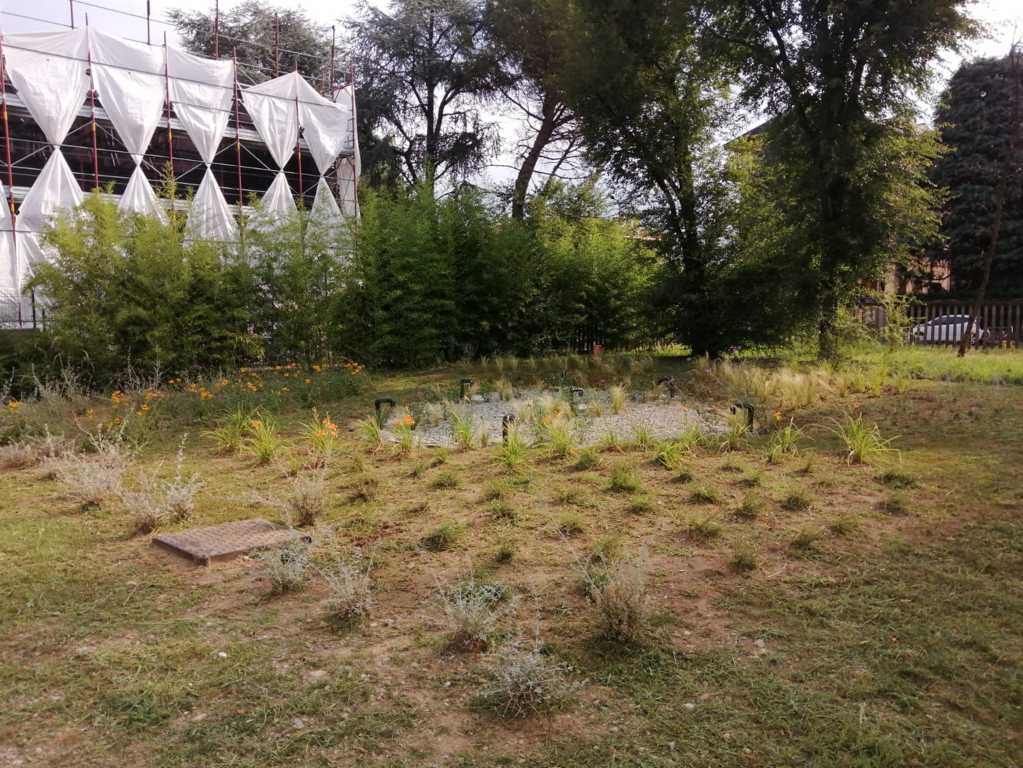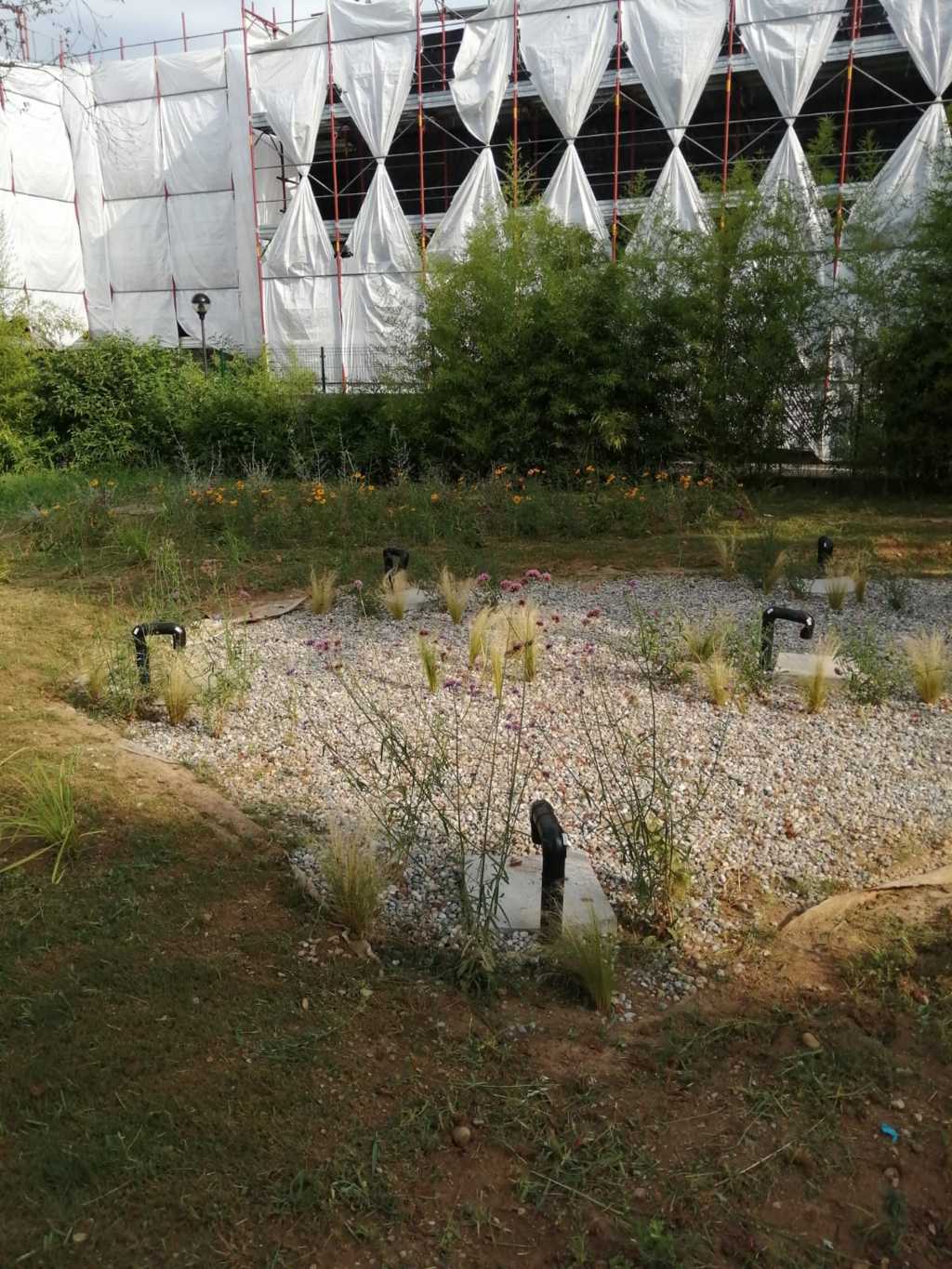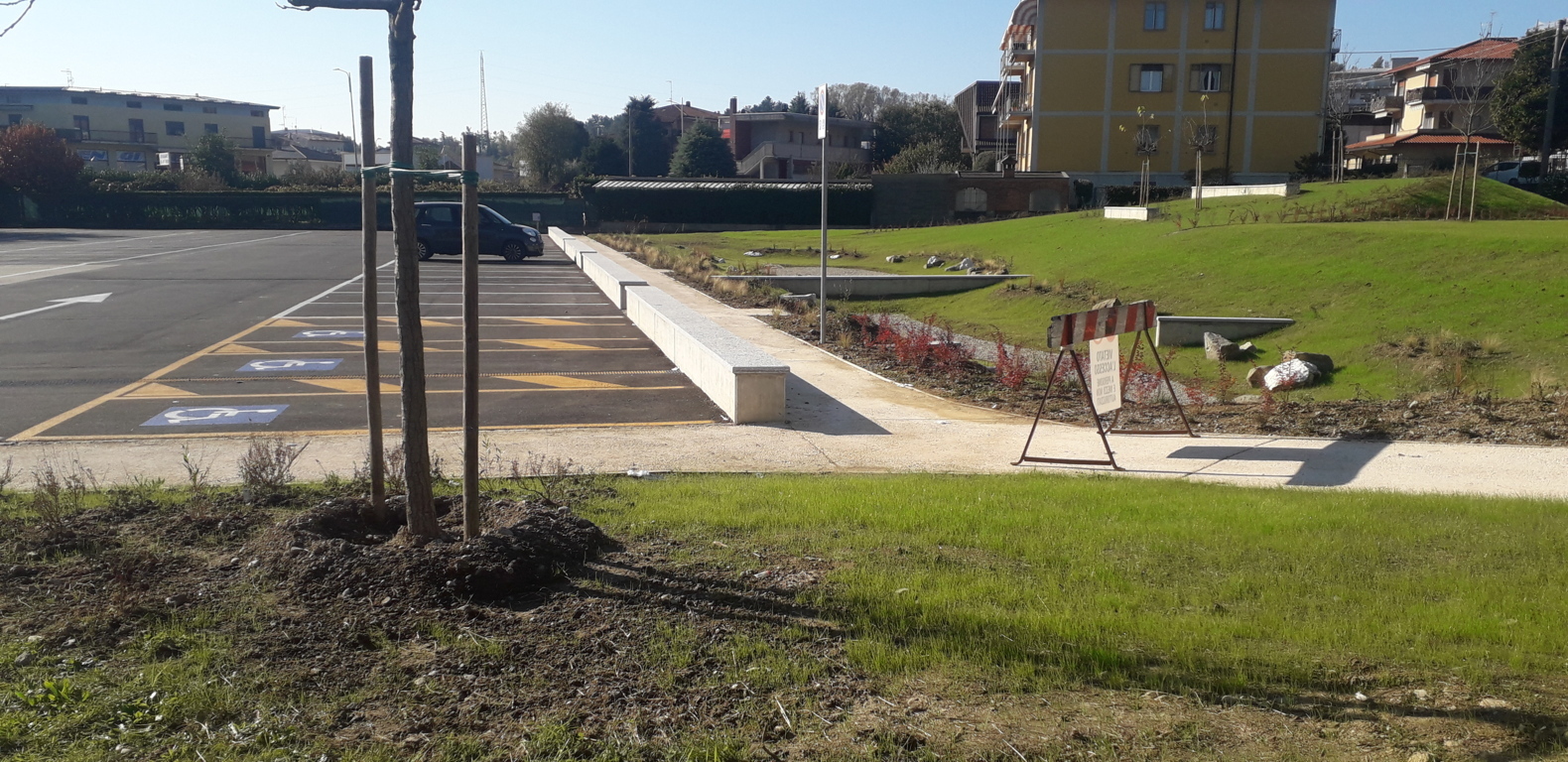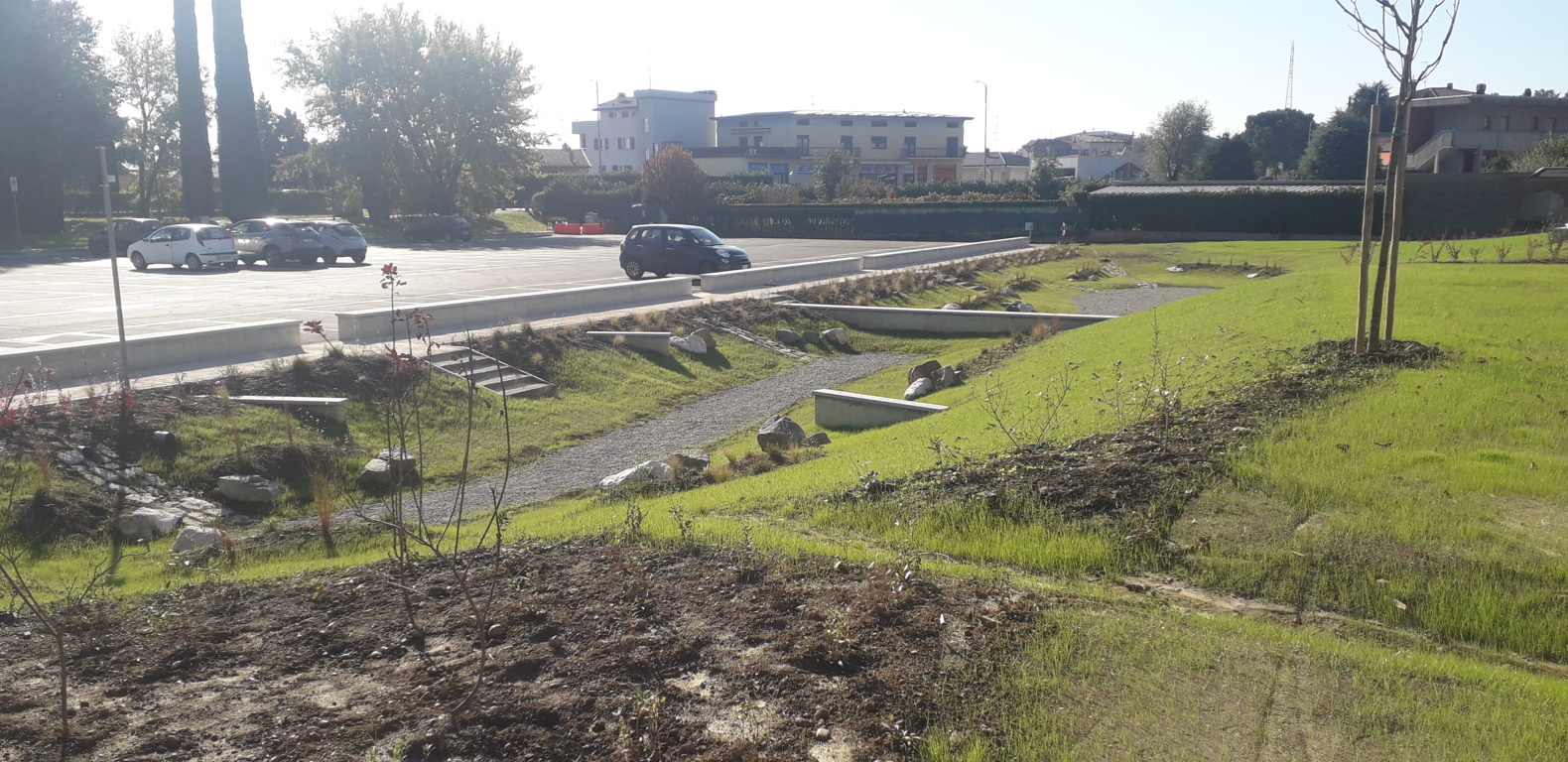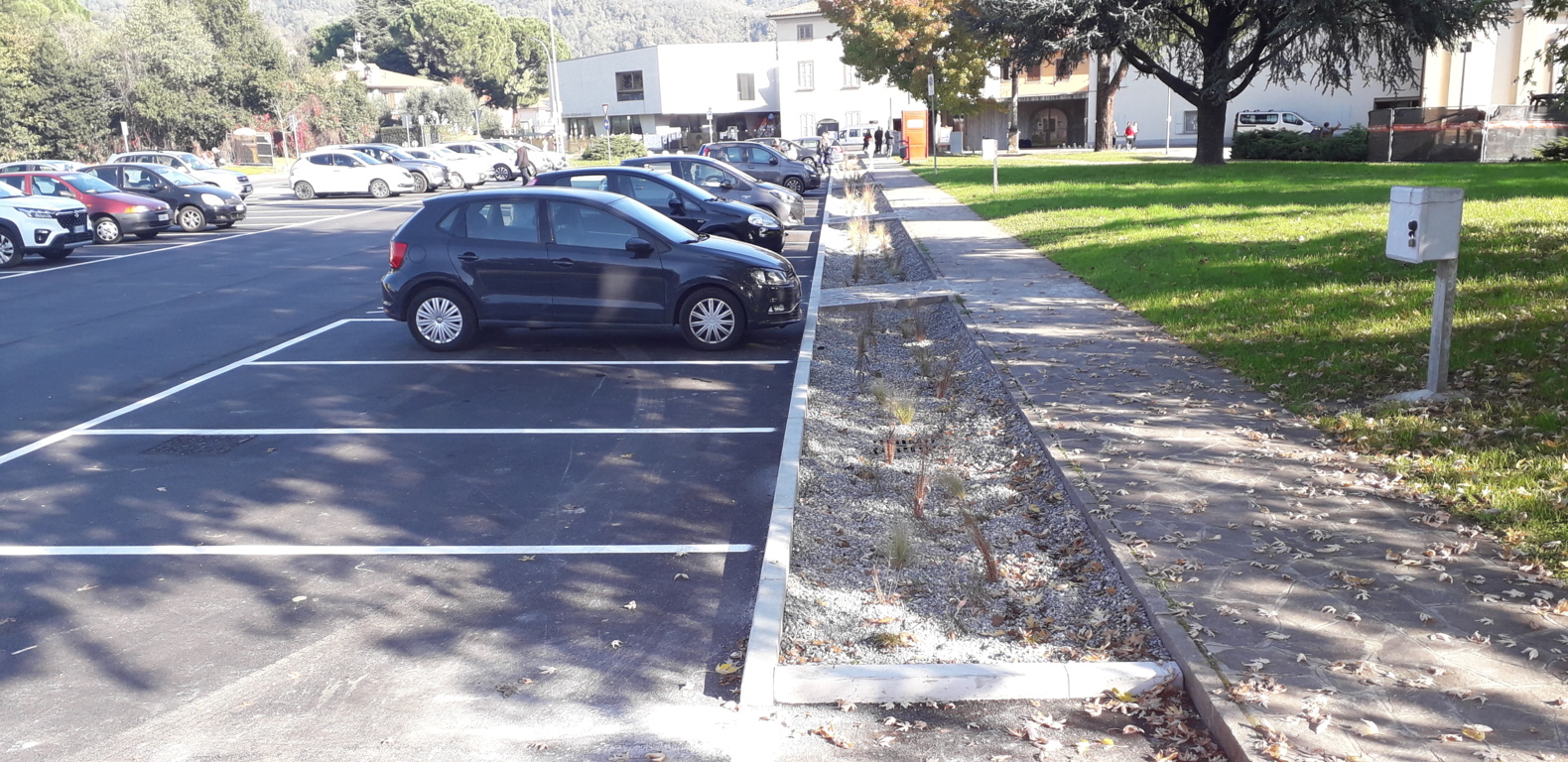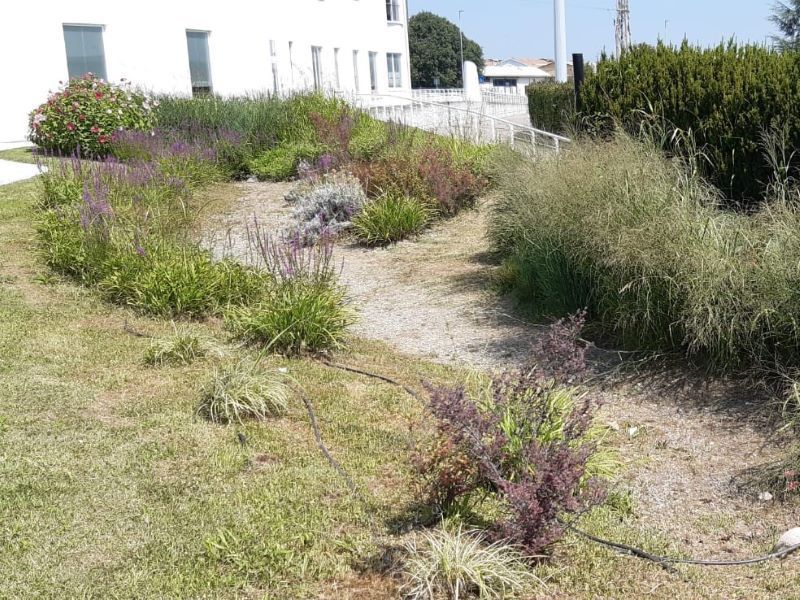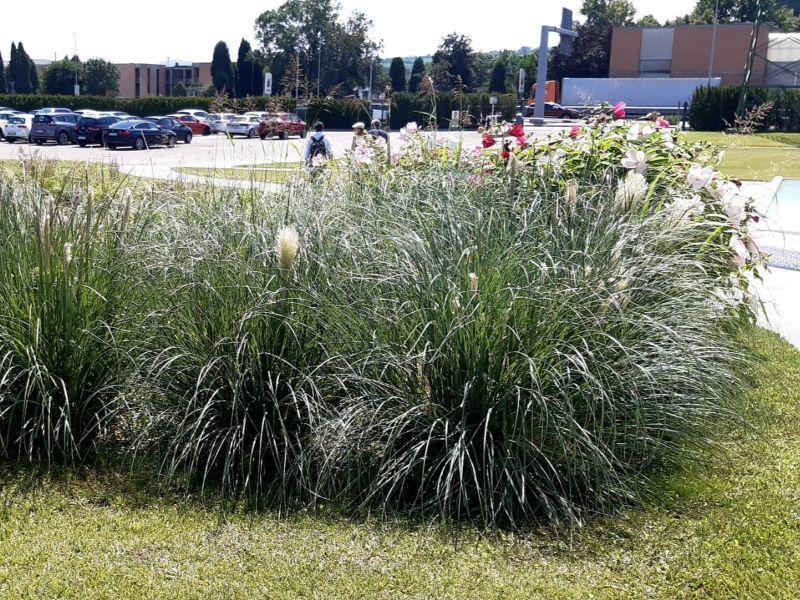Sustainable drainage systems (SuDS) and sponge cites

Sustainable drainage systems (SuDS) want to manage urban runoff in order to: (i) restore hydrological balance and reduce pollutant loads of water bodies, moving from a post-urbanization back towards a pre-urbanization status of water bodies; (ii) build the so-called Sponge Cities, i.e. cities able to soak the urban runoff and mitigate flood effects; (iii) build green-blue infrastructure able to exploit all the Ecosystem Services of Nature-Based Solutions.
IRIDRA proposes SuDS solutions for sustainable management of rainwater, trying to conjugate the environmental needs with the possibility to restore neglected urban areas.
The drainage of urban runoff was usually underestimated in the planning and design of current cities. It resulted in serious hydraulic risks once the cities increased too much the cover with impervious surfaces, leading to often urban flood events due to functioning in pressure of sewers. But the current approach leads also to many issues in terms of water quality, due to pollutant load conveyed to water bodies by first flushes and combined sewer overflows.
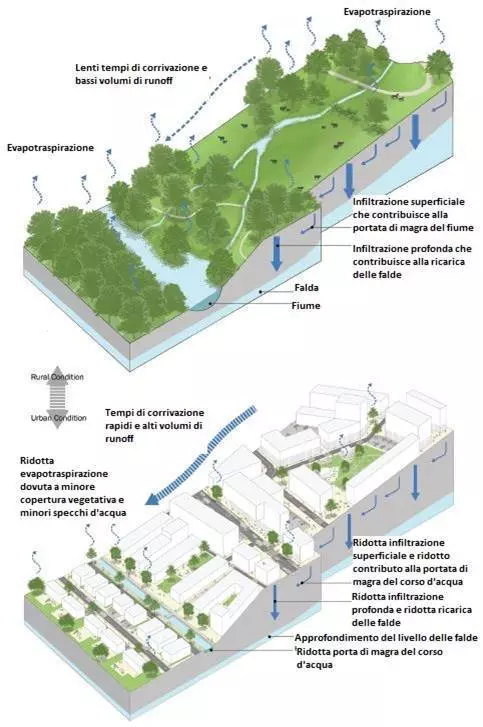 Source: Woods Ballard et al. 2015. "The SuDS Manual"
Source: Woods Ballard et al. 2015. "The SuDS Manual"
Sustainable drainage systems - the concept
Sustainable Drainage Systems (SuDS) want to manage urban runoff to:
- recover the original hydrologic regime and reduce the pollutant loads, moving from post-development back again to pre-development status;
- build future sponge cities in response to heavy rains;
- provide cities with as much as possible new green-blue infrastructures, exploiting the multiple ecosystem services of nature-based solutions

Source: Woods Ballard et al. 2015. "The SuDS Manual"
SuDS and Ecosystem services
Ecosystem services are defined as the "direct or indirect contribution of an ecosystem to human wellbeing".
SuDS techniques provide a number of different ecosystem services additional to that of runoff drainage. For instance, 17 examples of ecosystem services given by SuDS - Soft Engineering - instead of conventional solutions - Hard Engineering - are reported (Huber, 2010):
- atmospheric regulation
- climate regulation
- disturbance regulation
- water regulation
- water supply
- erosion control and sediment retention
- soil formation
- nutrient cycling
- waste treatment
- pollination
- species control
- refugia/habitat
- food production
- genetic resources
- recreation
- cultural enrichment
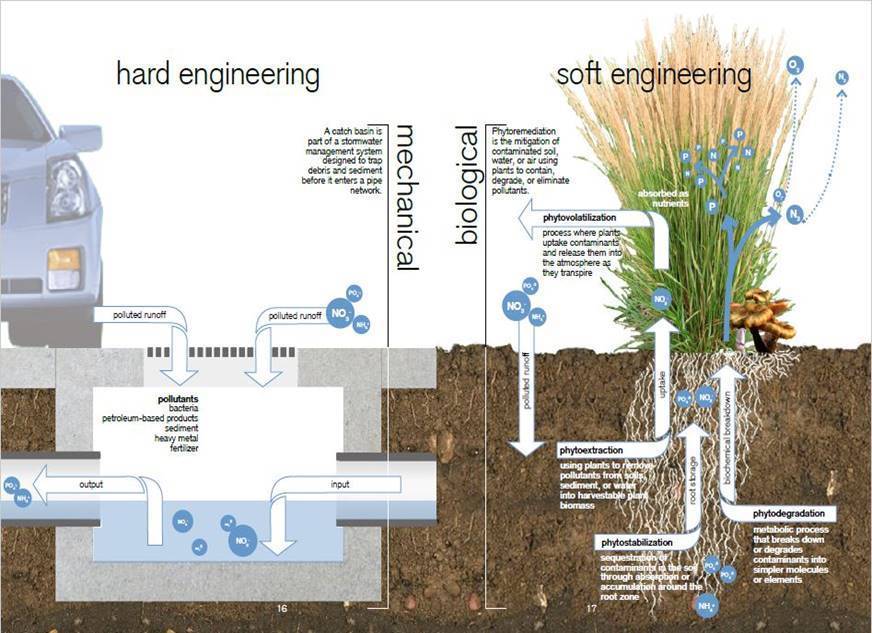
Source: Huber, J., 2010. Low Impact Development: a Design Manual for Urban Areas
SuDS and Green-Blue Infrastructures
Green-Blue Infrastructure is defined as a network of green and blue spaces exploiting ecosystem services to provide benefit for people and the environment.
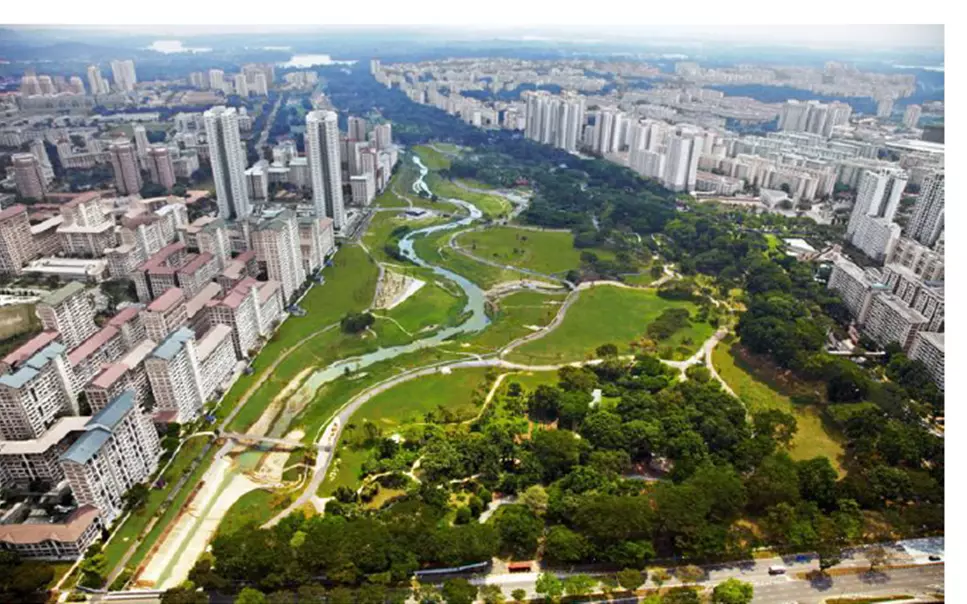
Urban park following a SuDS approach in Singapore (Bishan). Source: Gibelli G., 2015, Manuale di drenaggio urbano (in Italian)
SuDS and Sponge Cities
Sponge city is a concept developed in China, in which the city is required to adsorb urban runoff as "sponges" in order to reduce the flood risks driven by increased urbanization. In this clear how a SuDS approach is suitable to develop Sponge cities.
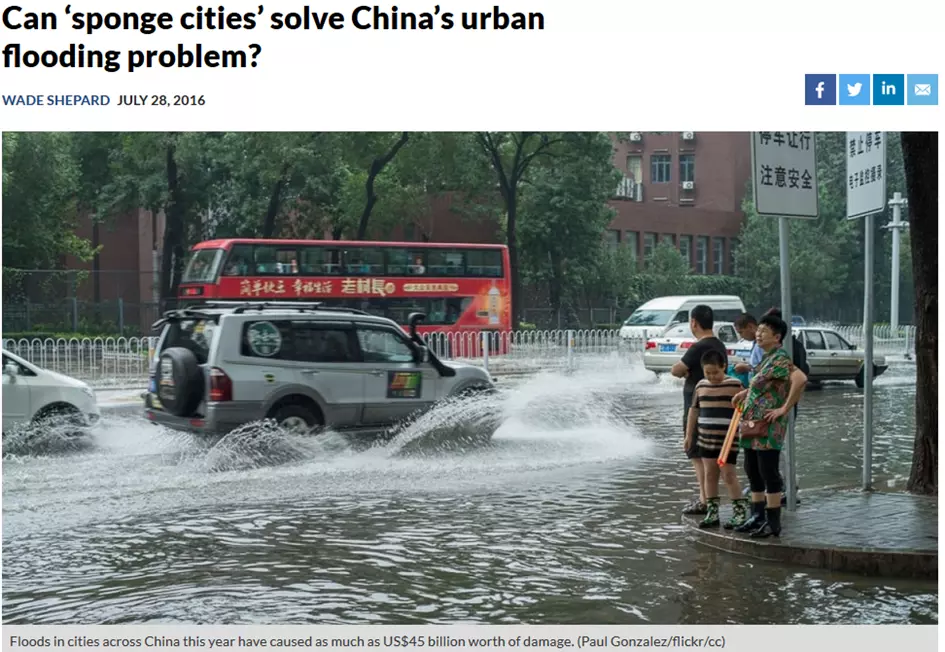
SuDS, WSUD, LID, BMPs ...
The SuDS approach is known in literature with different keywords, developed by research groups of different states. The most known ones are the following:
- SuDS Sustainable Drainage Systems
- WSUD Water Sensitive Urban Design
- LID Low Impact Development
- BMP Best Management Practices

SuDS experiences - International

Atelier Dreiseitl, Potdamer Plaza, Berlino (Germania)

Tanner Springs Park, Portland (USA)
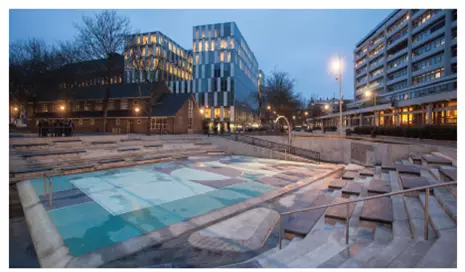
Water Plaza, Rotterdam (Olanda). Fonte: Gibelli G., 2015, Manuale di drenaggio urbano
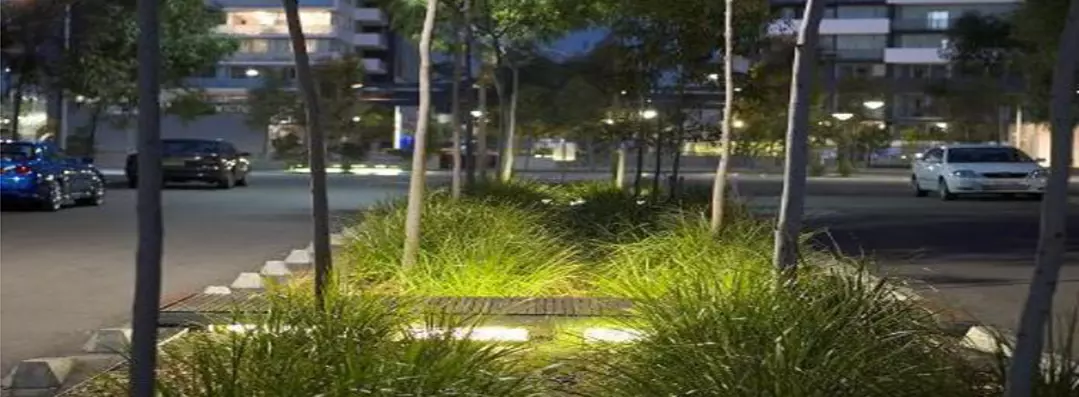
Sydney (Australia). Fonte: Gibelli G., 2015, Manuale di drenaggio urbano
References
IRIDRA's authors are highlighted in bold.
Masi F., Rizzo A., Bresciani R., Sustainable Rainwater Management in the City: Opportunities and Solutions for the Anthropic Environmental Impacts Reduction and Urban Resilience Increase, in "Smart Metropolia - Przestrzenie RelacjiPublisher: Obszar Metropolitalny Gdansk-Gdynia-Sopot ul. Dlugi Targ 39/40, 80-830 Gdansk, 109-119; 978-83-65496-02-07, 2018.
Huber, J., 2010. Low Impact Development: a Design Manual for Urban Areas. Fay-etteville, AR: University of Arkansas Community Design Center.
Woods Ballard, B., Wilson, S., Udale-Clarke, H., Illman, S., Scott, T., Ashley, R. and Kellagher, R., 2015. The SuDS Manual, C753, CIRIA, London, UK. ISBN 978-0-86017-760-9.
SuDS and sponge cities implementation scales
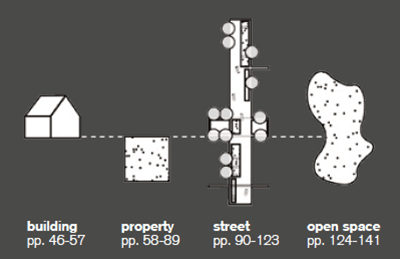
The different sustainable drainage systems (SuDS) allow to propose a SuDS and sponge city approaches at different implementation scales, which can be subdivided as follow:
- building
- property lots
- street and parking
- open spaces
- Retrofitting of existing green areas
IRIDRA proposes the SuDS and sponge cities approach for all the scales, from single houses to public open spaces, up to big peri-urban areas.
Single house scale
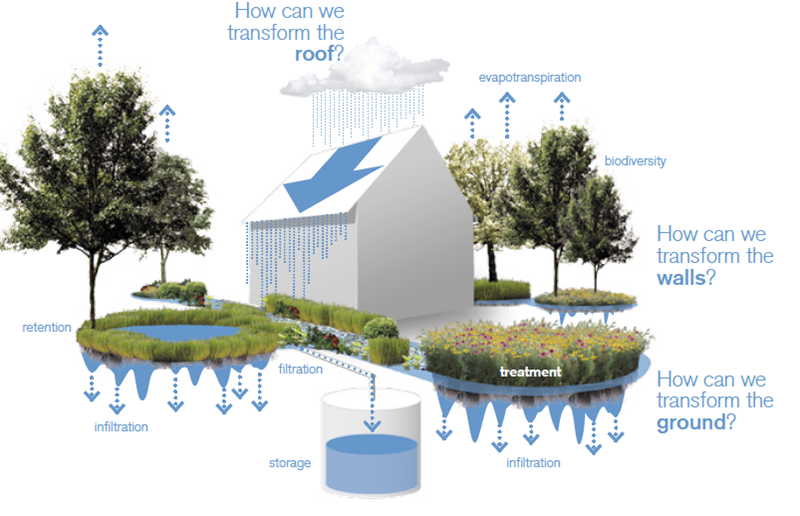
Source: Huber, J., 2010. Low Impact Development: a Design Manual for Urban Areas
Lot scale
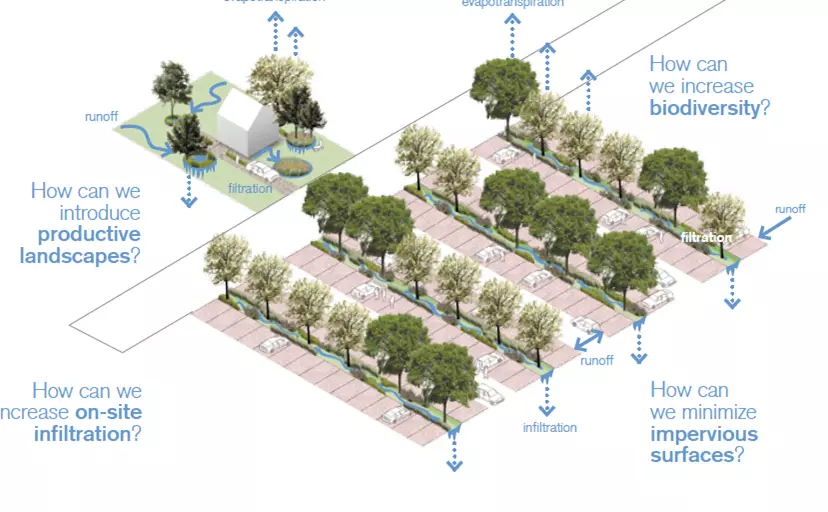 Source: Huber, J., 2010. Low Impact Development: a Design Manual for Urban Areas
Source: Huber, J., 2010. Low Impact Development: a Design Manual for Urban Areas
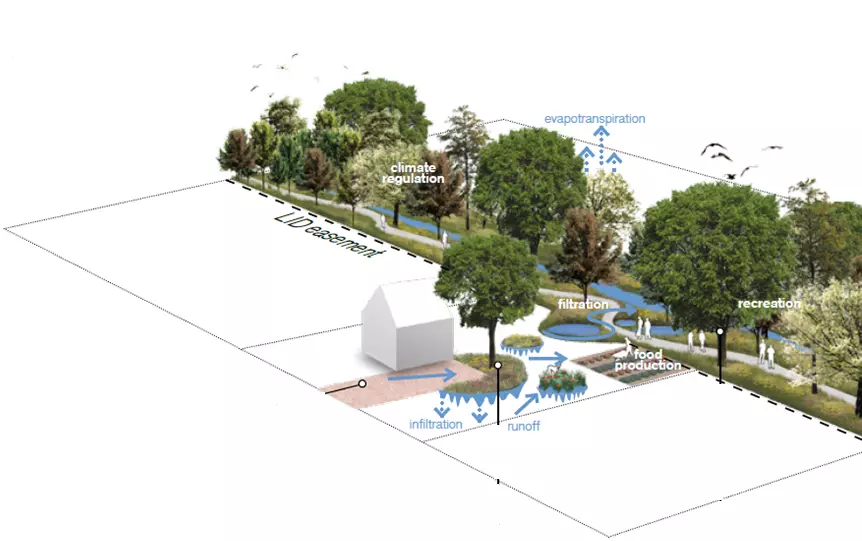
Source: Huber, J., 2010. Low Impact Development: a Design Manual for Urban Areas
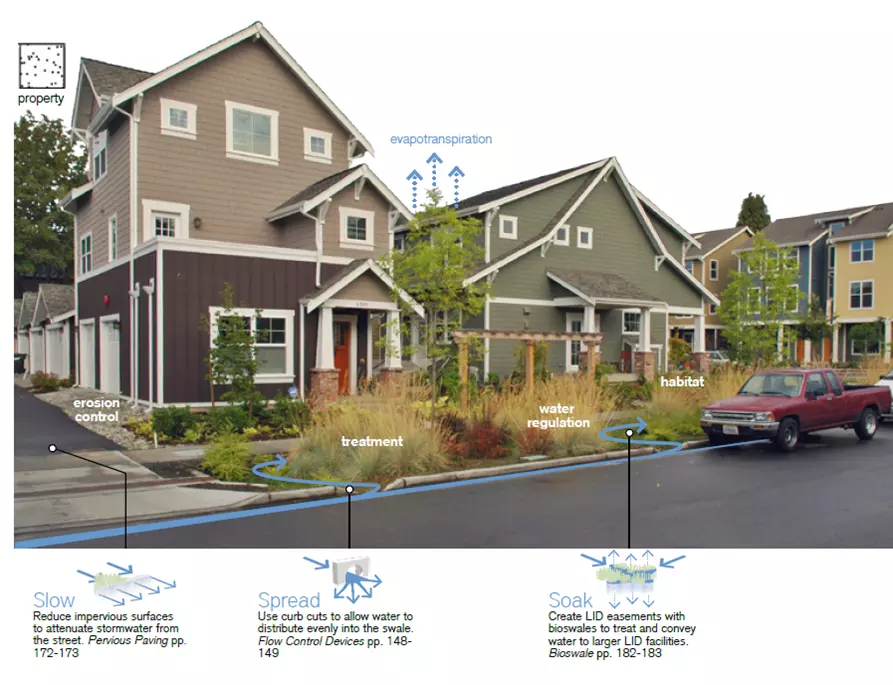
Source: Huber, J., 2010. Low Impact Development: a Design Manual for Urban Areas
Parking
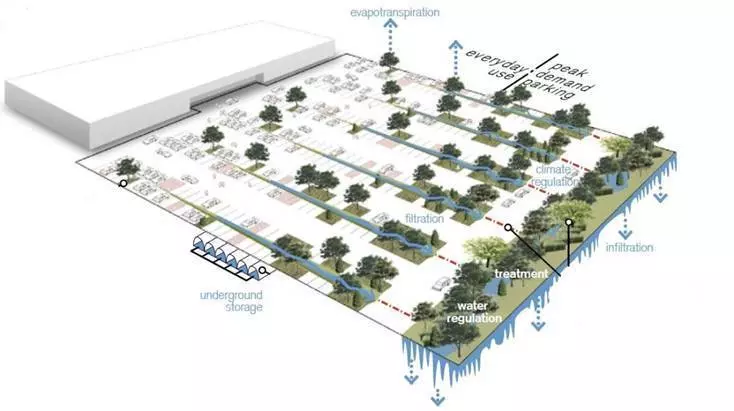
Source: Huber, J., 2010. Low Impact Development: a Design Manual for Urban Areas
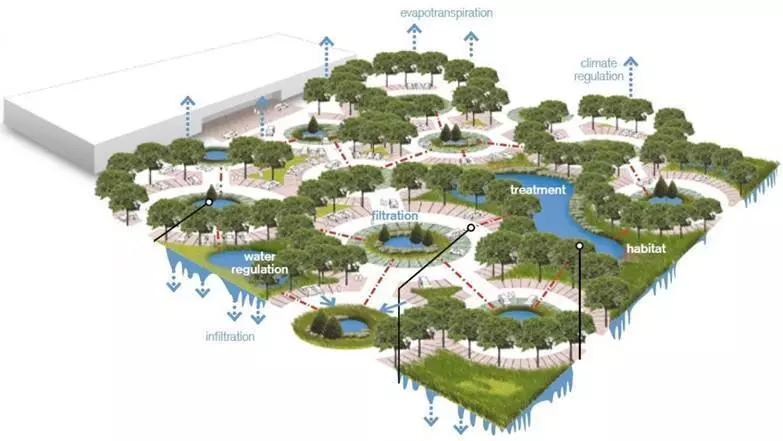
Source: Huber, J., 2010. Low Impact Development: a Design Manual for Urban Areas
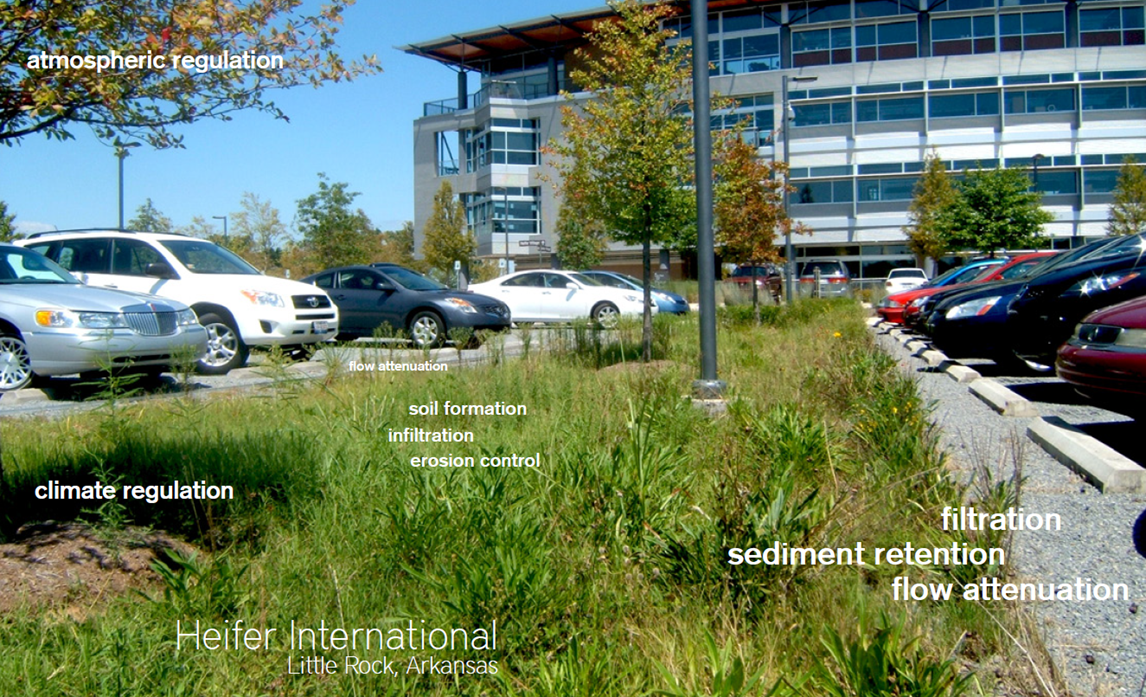
Source: Huber, J., 2010. Low Impact Development: a Design Manual for Urban Areas
Roads

Source: Huber, J., 2010. Low Impact Development: a Design Manual for Urban Areass
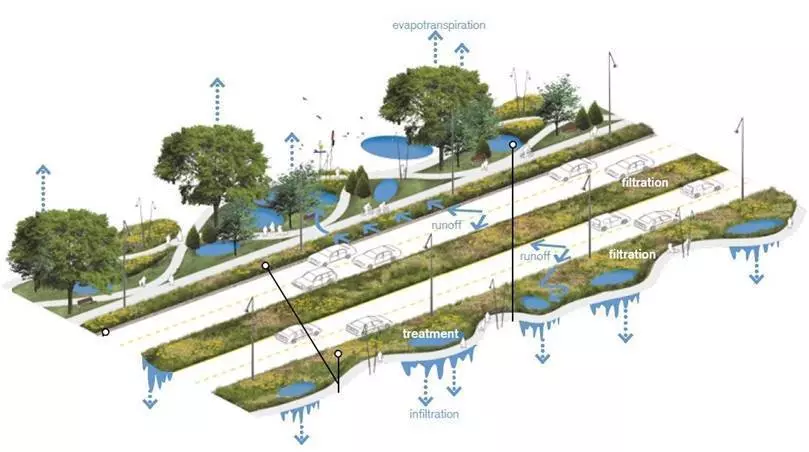
Source: Huber, J., 2010. Low Impact Development: a Design Manual for Urban Areas
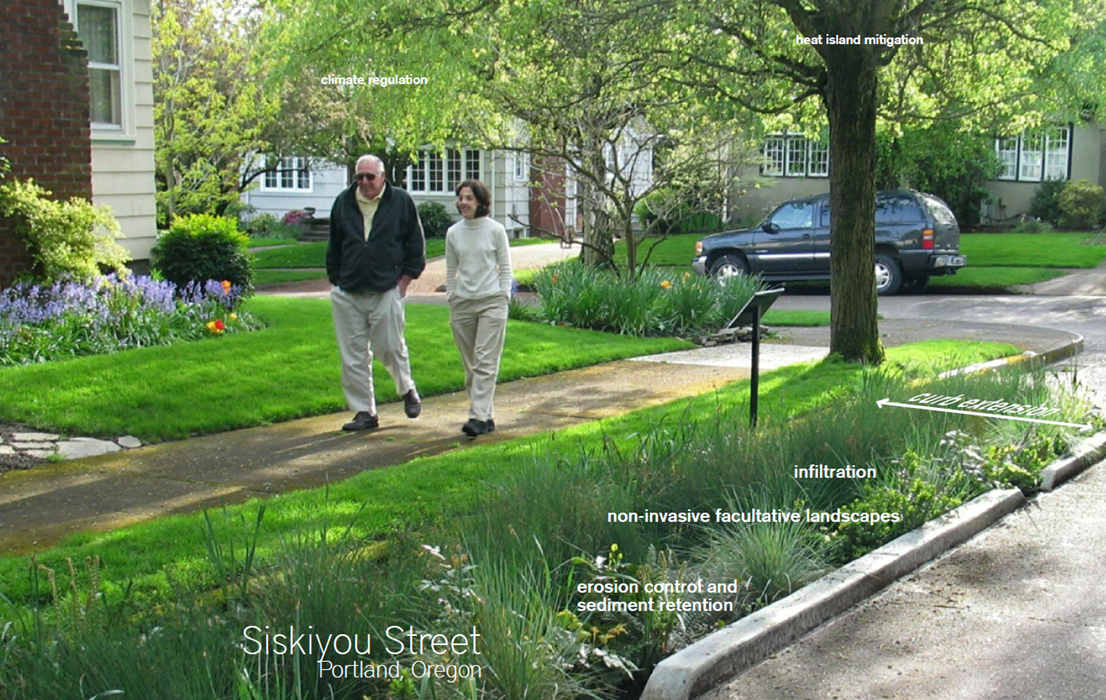
Source: Huber, J., 2010. Low Impact Development: a Design Manual for Urban Areas
Urban planning and public spaces
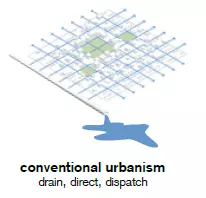 |
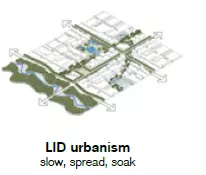 |
Source: Huber, J., 2010. Low Impact Development: a Design Manual for Urban Areas
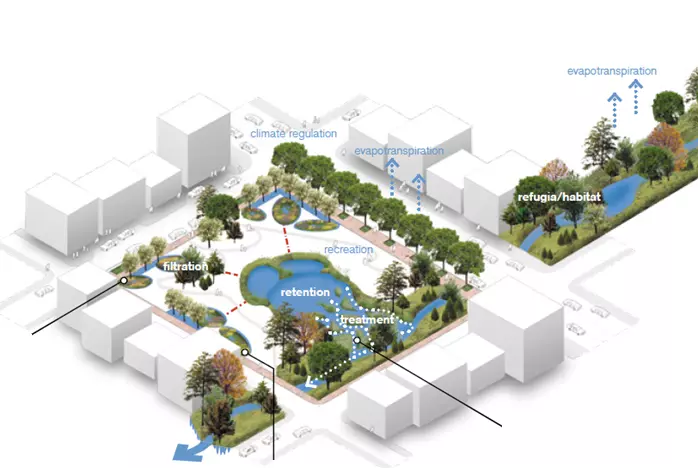
Source: Huber, J., 2010. Low Impact Development: a Design Manual for Urban Areas
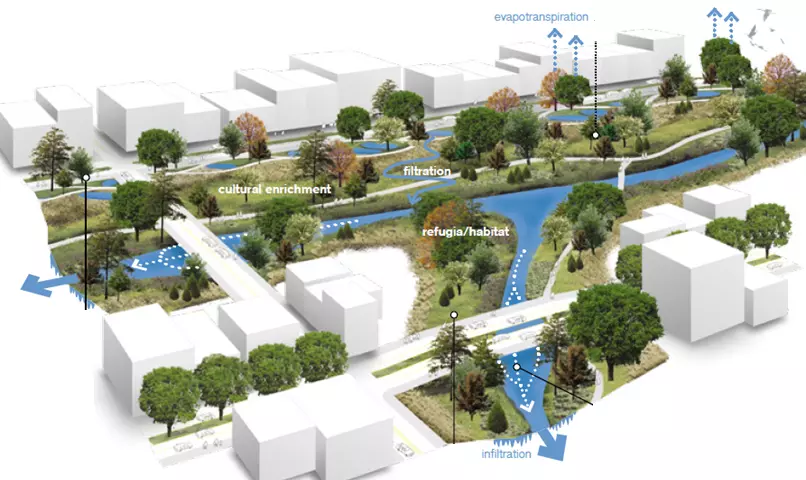
Source: Huber, J., 2010. Low Impact Development: a Design Manual for Urban Areas
Retrofitting of existing green areas
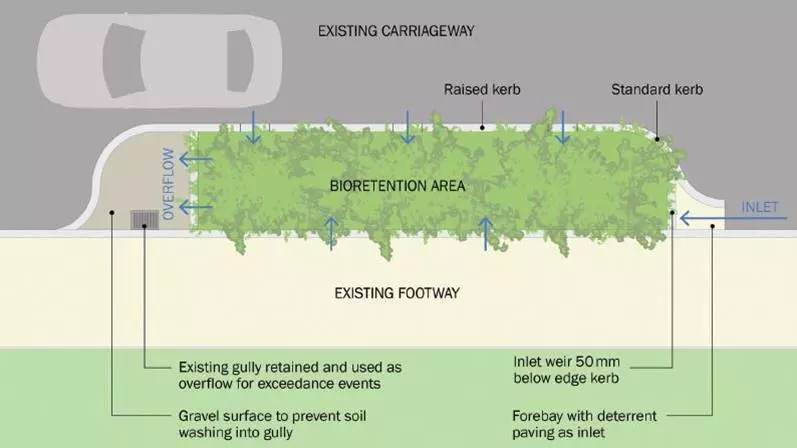
Source: Woods Ballard et al. 2015. "The SuDS Manual"
References
IRIDRA's authors are highlighted in bold.
Masi F., Rizzo A., Bresciani R., Sustainable Rainwater Management in the City: Opportunities and Solutions for the Anthropic Environmental Impacts Reduction and Urban Resilience Increase, in "Smart Metropolia - Przestrzenie RelacjiPublisher: Obszar Metropolitalny Gdansk-Gdynia-Sopot ul. Dlugi Targ 39/40, 80-830 Gdansk, 109-119; 978-83-65496-02-07, 2018.
Huber, J., 2010. Low Impact Development: a Design Manual for Urban Areas. Fay-etteville, AR: University of Arkansas Community Design Center.
Woods Ballard, B., Wilson, S., Udale-Clarke, H., Illman, S., Scott, T., Ashley, R. and Kellagher, R., 2015. The SuDS Manual, C753, CIRIA, London, UK. ISBN 978-0-86017-760-9.
Techniques of Sustainable drainage systems (SuDS)

Techniques of Sustainable drainage systems (SuDS) are various and allow reaching different multidisciplinary goals: flood protection, water quality improvement, urban restoration or biodiversity increase. In function of which goal wants to be maximized, it is possible to use simple trench filters, going through vegetated swales, up to bioretention systems, ponds, and wetlands.
IRIDRA has all the multidisciplinary expertise to propose different SuDS techniques, in function of different required goals.
Rain water harvesting
|
|
|
Source: Woods Ballard et al. 2015. "The SuDS Manual"
Green roofs

Source: Woods Ballard et al. 2015. "The SuDS Manual"
Infiltration basins
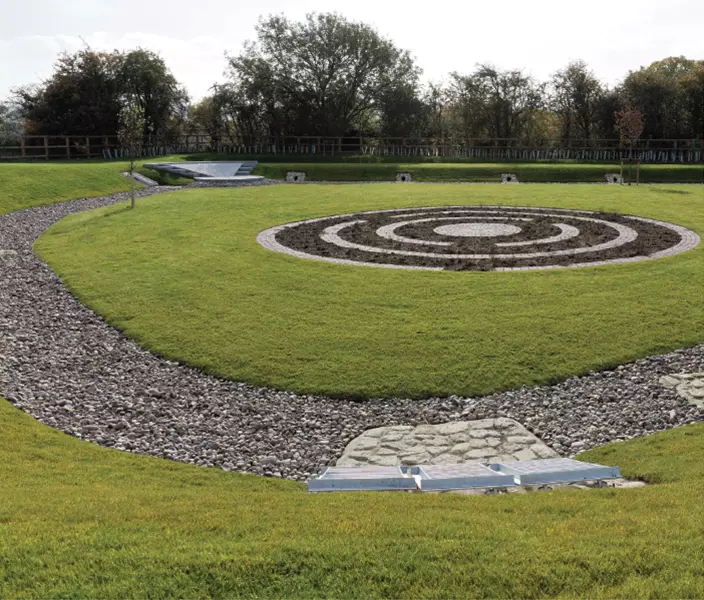
Fonte: Woods Ballard et al. 2015. "The SuDS Manual"
Swales
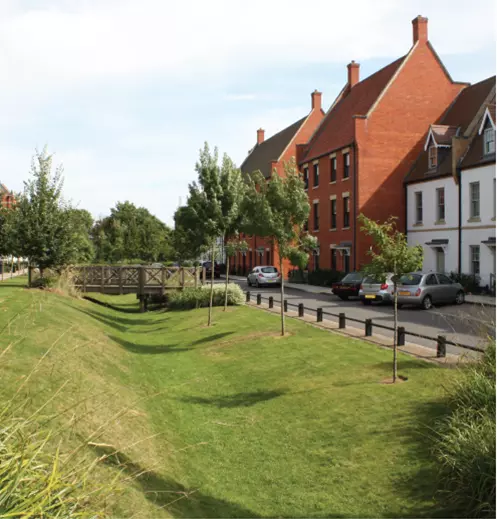
Source: Woods Ballard et al. 2015. "The SuDS Manual"
Bioretention systems
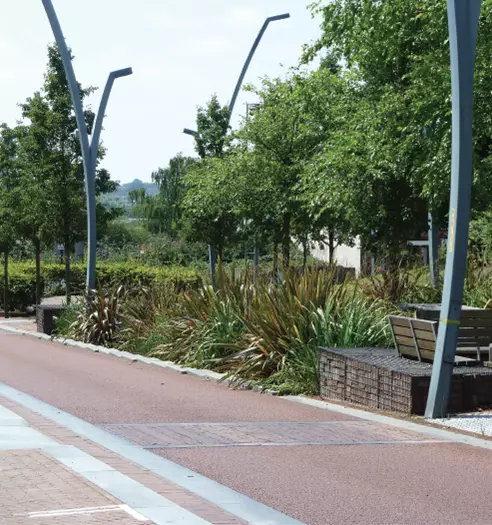
Source: Woods Ballard et al. 2015. "The SuDS Manual"
Infiltration trees
|
|
|
Source: Woods Ballard et al. 2015. "The SuDS Manual"
Detention basins
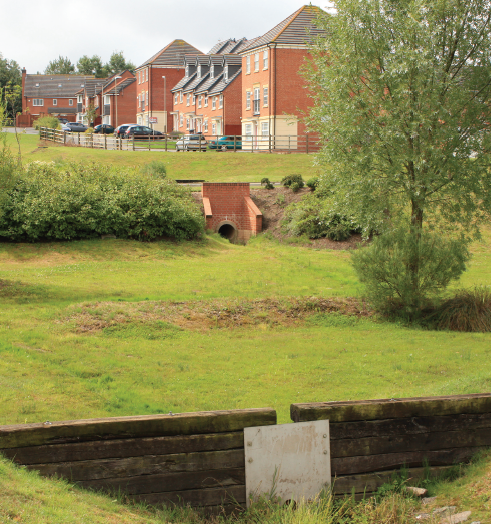
Source: Woods Ballard et al. 2015. "The SuDS Manual"
Ponds
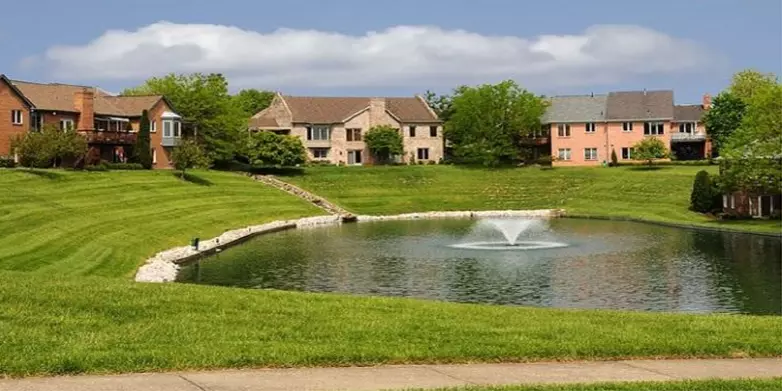
Source: Gibelli G., 2015, Manuale di drenaggio urbano
Wetlands
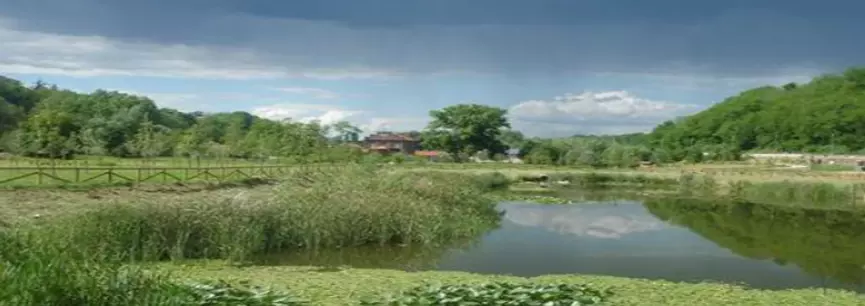
Source: Gibelli G., 2015, Manuale di drenaggio urbano
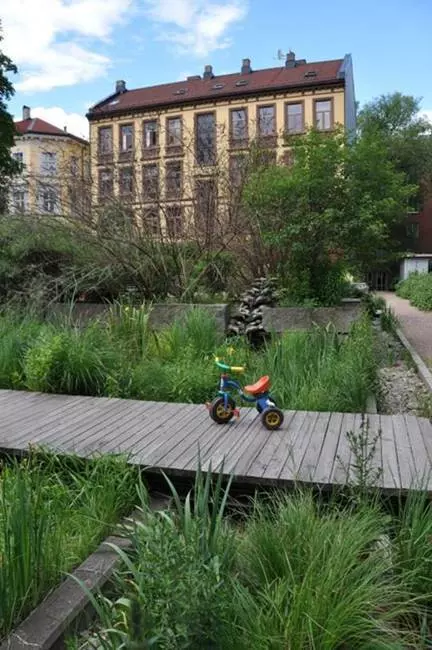
Courtesy: Jaime Nivala
References
IRIDRA's staff is highlighted in bold.
Masi F., Rizzo A., Bresciani R., Sustainable Rainwater Management in the City: Opportunities and Solutions for the Anthropic Environmental Impacts Reduction and Urban Resilience Increase, in "Smart Metropolia - Przestrzenie RelacjiPublisher: Obszar Metropolitalny Gdansk-Gdynia-Sopot ul. Dlugi Targ 39/40, 80-830 Gdansk, 109-119; 978-83-65496-02-07, 2018.
Huber, J., 2010. Low Impact Development: a Design Manual for Urban Areas. Fay-etteville, AR: University of Arkansas Community Design Center.
Woods Ballard, B., Wilson, S., Udale-Clarke, H., Illman, S., Scott, T., Ashley, R. and Kellagher, R., 2015. The SuDS Manual, C753, CIRIA, London, UK. ISBN 978-0-86017-760-9.
IRIDRA's projects
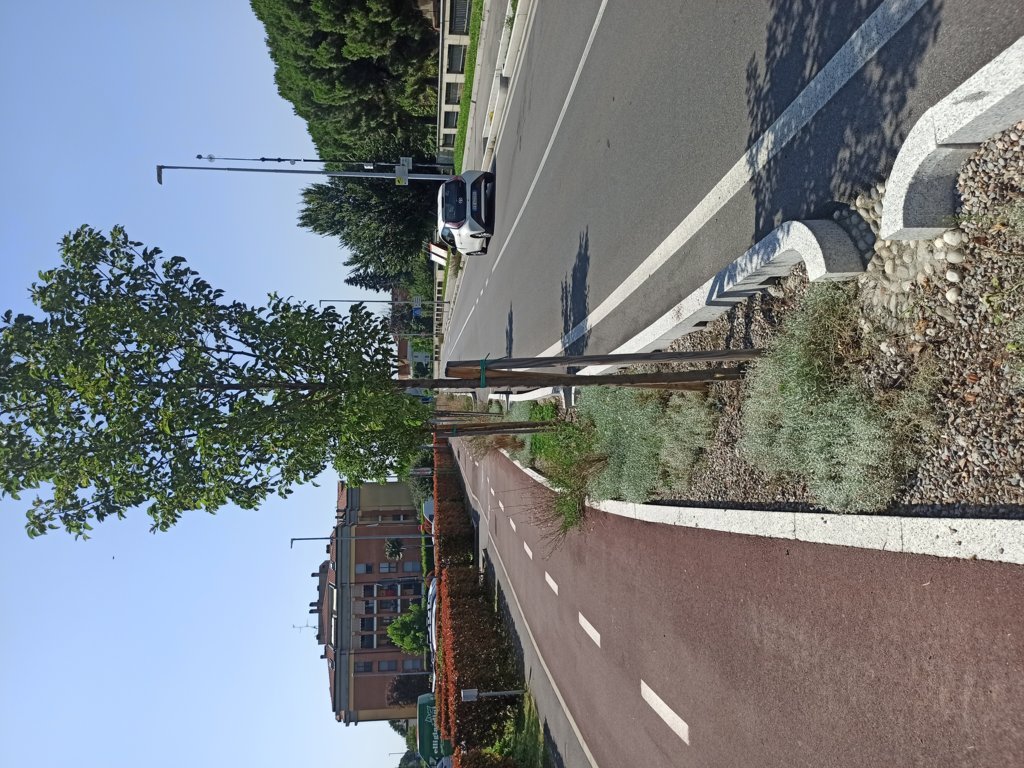
Retrofitting SuDS Matteotti boulevard, Bovisio Masciago (MB - Italy)
Chosen SuDS solution: Bioretention systems, urban detention basins
Peculiarity: Within the framework of urban desealing interventions with SuDS, it was taken the chance to design multipurpose elements able to also provide urban restoration.
Year of design: Preliminary design, 2021; Detailed design 2022; Completed
The project followed the principle of multidisciplinary sustainable drainage system (SuDS) design, promoting a SuDS retrofitting intervention capable of providing benefits in terms water quantity, water quality, biodiversity and amenity, and creating a long linear green infrastructures in the urban area. The intervention consists in decreasing the width of the existing road to recover space of including about 1000 m2 of the bioretention systems and a cycle lane. In terms of Water quantity, the SuDS have been designed to retain low intensity rain events, permitting to avoid discharging in combined sewer, on average, 10000 m3/y, draining an impervious surface of about 12000 m2. In terms of Water quality, the porous media of the bioretention systems have been selected to provide an effective treatment of the pullutants in the stormwater first flush generated by the deposits of pollutant on the roads during dry periods, guaranteeing and effective removal of solids and metals. Regarding Biodiversity, about 1000 m2 of paved surface have been greened back and planted with 14 different shrubs and 7 different trees, contributing also to other benefits typical of urban greening, such as heat island reduction, air pollution control, and noise attenuation. Moreover, the urban greening permitted to achieve also the Amenity benefits; being designed according the SuDS principle, the multipurpose SuDS elements drain in 24-48 hours, permitting to live the area in dry period. To this aim, also a small abandoned square have been recovered, including multipurpose SuDS element together with typical restoration intervention, such as educative games for kids and urban forestation elements.

Retrofitting SuDS area Mercato presso via Paganini, Bovisio Masciago (MB)
Chosen SuDS solution: Bioretention systems with trees, urban detention basins
Peculiarity: Within the framework of urban desealing interventions with SuDS, it was taken the chance to design multipurpose elements able to also provide urban restoration of the market area, currently fully impermeable and without green spaces.
Year of design: Preliminary design, 2021; Detailed design 2021; Completed
The opportunity was taken to finance reforestation works for a real redevelopment of the area. From a hydraulic point of view, the de-sealing work contributes to a reduction of water loads on the rainwater collection network; from the point of view of the liveability of urban spaces, it contributes to improving their quality, reducing the heat island effect, controlling the albedo of the external surfaces, intervening with urban greenery to reduce CO2 and consequently, making these spaces usable also in concert with the stakeholders, to encourage initiatives for new social activities and outdoor living.
The project envisages SuDS retrofitting works spread over the entire Market area using the space obtained from the non-concessionary stalls.
There are three elements that distinguish it: the large bioretention area in front of the shopping centre, the linear suds in front of the new shrub and tree belt in the area where the stands were located, and the island suds that cut across the entire market area twice.
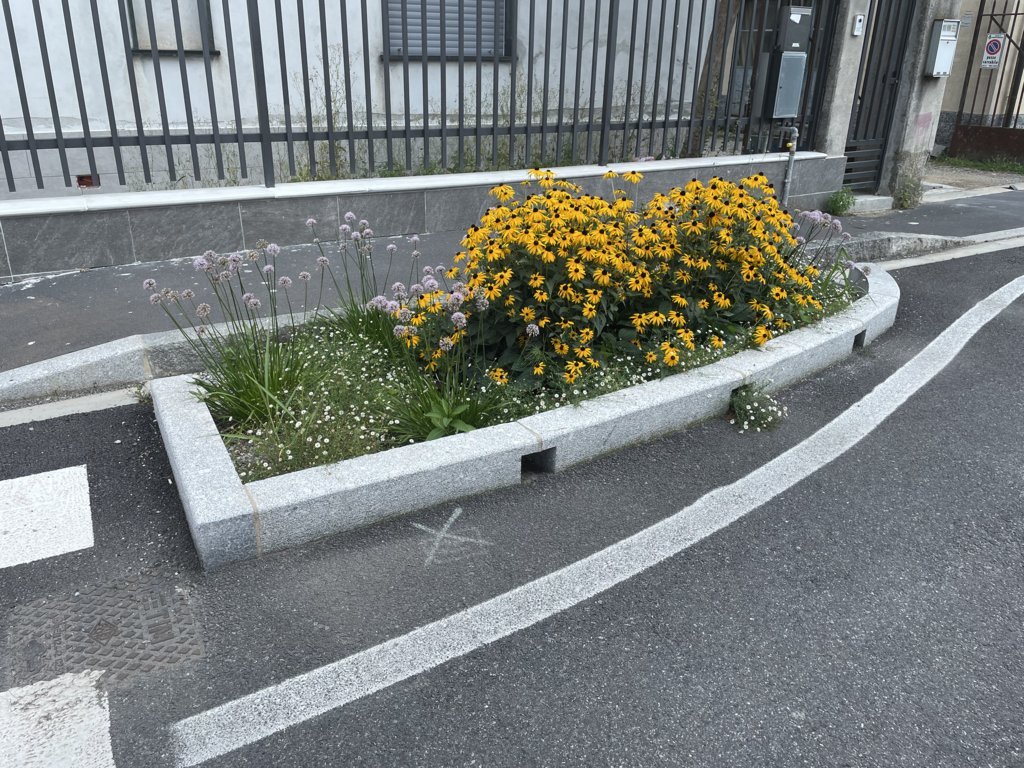
Desealing of via Repubblica by retrofitting SuDS, Bovisio Masciago (MB)
Chosen SuDS solution: Bioretention areas
Peculiarity: Overall, these interventions also contribute to the rationalisation of parking areas, pedestrian routes and accesses and, by inserting plantations of various types, they strongly contribute to the improvement of the negative effects of the heat island and to the abatement of dust and pollutants.
Year of design: Preliminary design, 2021; Detailed design 2021; Completed
The intervention in Via della Repubblica consists mainly of a reorganisation of the road axis by inserting urban drainage systems to relieve the mixed sewage system. The new layout has been realised so that water flows into the bioretention systems directly or through the gutters, the road and pavements have been recalibrated, allowing for large SuDS areas on the east and west side along the road.
For Via della Repubblica, the area of intervention is approximately 1012 square metres and is distributed as follows.
- new driveway
- new pavements on both sides
- 79 square metres of parking area
- 112 sq m of bioretention areas positioned along the road axis, for the drainage of surface water from the driveway, parking areas and pavements.
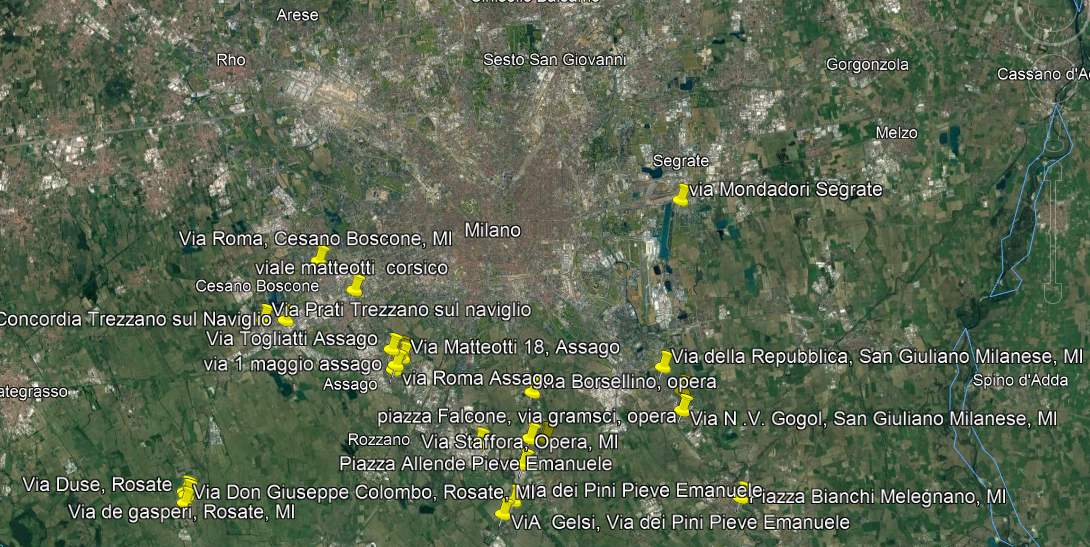
Integrated Urban Plan Metropolitan Sponge City, Metropolitan City of Milan
Chosen SuDS solution: Bioretention areas, permeable paving, detention basins, vegetated swales, infiltration trenches, permeable pavements
Peculiarity: IRIDRA designed 26 of the 90 interventions in 32 municipalities foreseen by the Sponge Metropolitan City Integrated Urban Plan. Integrated Urban Plans are dedicated to the suburbs of Metropolitan Cities and provide for participatory urban planning, with the aim of transforming vulnerable territories into sustainable places.
Year of design: Feasibility study 2022; Final and executive design 2023
The "Integrated Urban Plans CMM Spugna" project of the Metropolitan City of Milan, has the objective of relieving the sewage network in various municipalities, to ensure the correct drainage of rainwater, in particular 26 interventions have been designed in 10 municipalities of the Metropolitan City of Milan. The project has chosen to propose unconventional solutions belonging to the families of "Sustainable Urban Drainage Systems" (SuDS) or "Nature-based Solutions" (NBS). Sustainable urban drainage systems are multi-functional systems that allow the management of rainwater on the surface, avoiding overloading the existing sewage network and treatment plants, and reducing local flooding phenomena. Since these are often multi-objective interventions, they are able to provide multiple ecosystem services and contribute to the improvement of the landscape. They also help reduce air, water and heat island pollution, providing support for biodiversity. Specifically, the designers' objective was to exploit the possibility of financing desealing interventions for a real redevelopment of the areas, which would allow, at the same time, to improve the hydrological response of the drained basin and the hydraulic functioning of the existing sewer and to provide benefits to the citizens. The solutions identified for the objectives set are solutions that allow easy insertion in the area of interest and the ability to offer multiple ecosystem services, among the solutions proposed are: rain gardens, detention basins, drainage trenches, permeable pavements, vegetated ditches and infiltrating geocellular modules. The sum of the surfaces of the SuDS elements of all 26 interventions is equal to 31 019 m2, for a total of 6314 m3 of lamination volume.
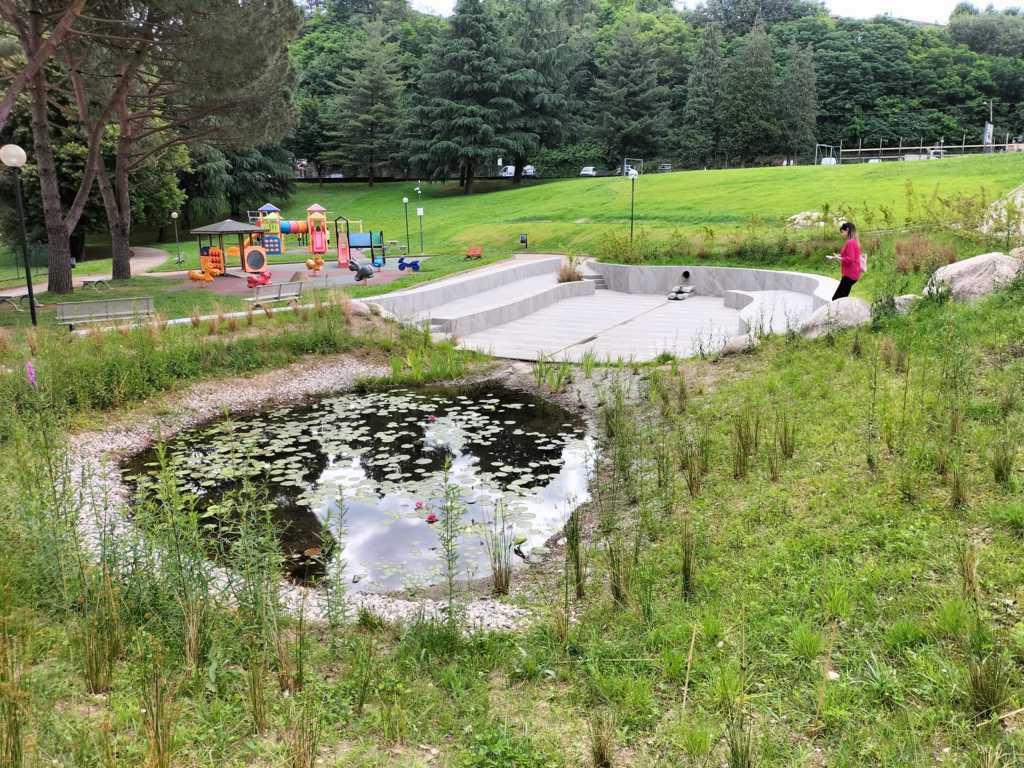
Desealing of public car park in Via Milano and redevelopment of neighbouring park with SuDS, Besozzo (VA)
Chosen SuDS solution: Bioretention areas, permeable paving, dry detention basins, wet detention basins
Peculiarity: Thanks in part to the incentives provided by the Lombardy Region's Call for Ideas #SuDS, promoted by ERSAF Lombardy, the interventions became an opportunity to propose a small open-air laboratory of SuDS solutions, with permeable paving, rainwater collection and recovery, bioretention areas with mineral dry detention basins (a small water plaza) and wet detention basins, and large flower meadows.
Year of design: Feasibility study 2022; Final and executive design 2023; Completed
In Besozzo, the de-sealing of the public car park in Via Milano and the redevelopment of the adjoining park was planned, using sustainable urban drainage solutions. Stormwater falling on the surface of the street and car parks in Via Milano is managed by multi-objective SuDS elements such as permeable pavements, dry basins with bioretention areas and wet detention basins. Stormwater falling on the surface of the car parks and the street passes through the filter material layer of the permeable pavement to the dry basin, from where it continues to the wet detention basin. From the basin the water is then discharged into the Bardello River.
Two storage tanks are also positioned in the north-west of the intervention area to collect rainwater from the roof of the ex-Sonnino area building in order to reuse it for the irrigation of the green roof.
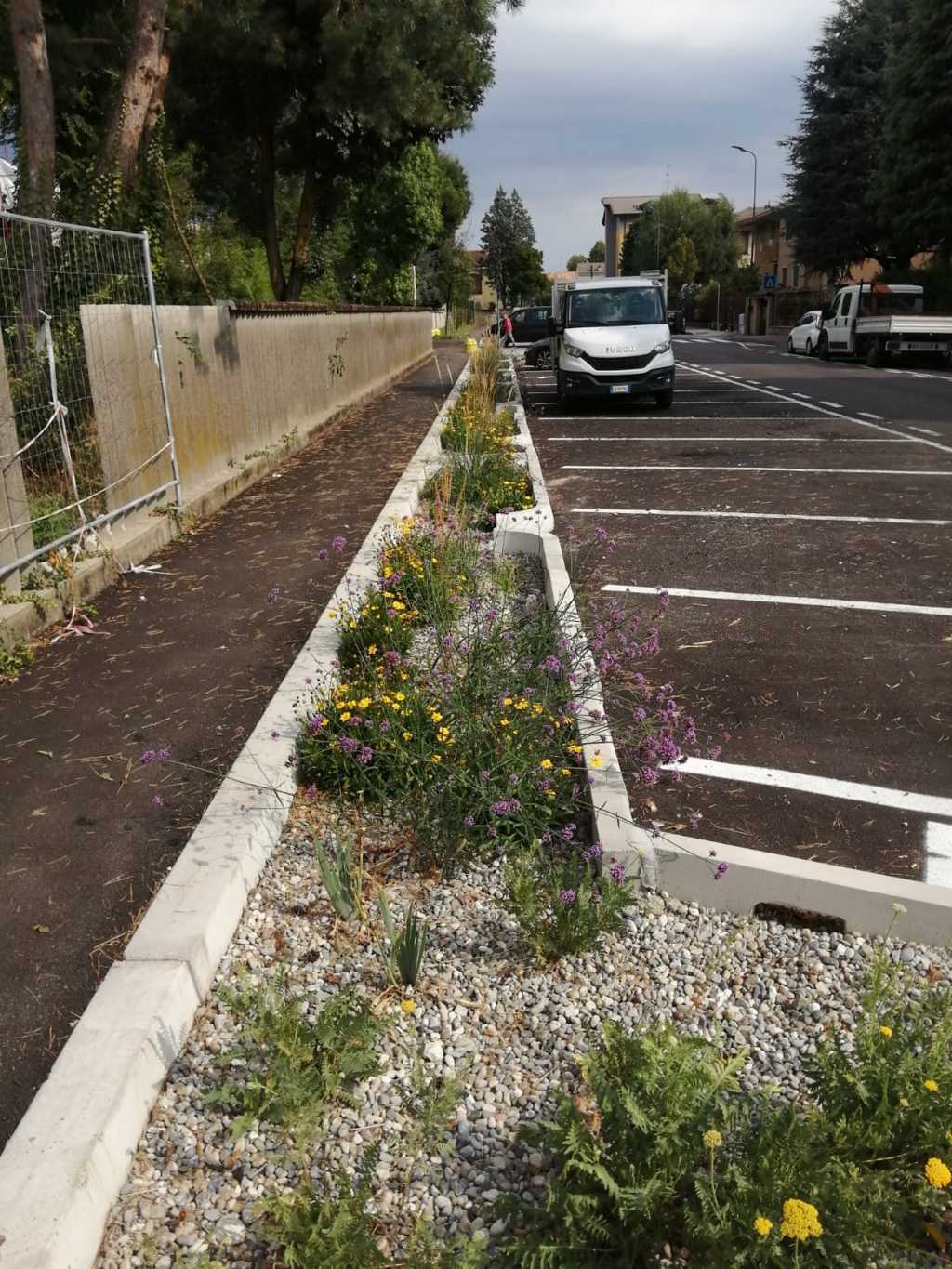
Construction of SuDS in Via J. F. Kennedy and rain garden for rainwater recovery from the roof of the adjacent school, Varedo (MB)
Chosen SuDS solution: Bioretention areas
Peculiarity: The water filtered by the rain garden is collected in an accumulation tank in order to reuse it both for irrigation and for possible use in the gymnasium (ACS or toilet flushing).
Year of design: PFTE 2022; Final and executive design 2022; Completed
The project consists of two interventions in the municipality of Varedo (MB), the de-sealing of Via F. Kennedy, to ensure the drainage of rainwater, and the management through SuDS of rainwater collected from the roofs of the F. Kennedy school.
The project includes the desealing of a longitudinal strip along the Via Kennedy car park and the construction of 154.5 m2 bioretention areas. These de-sealed spaces, located in front of the car parks and near the entrance area to the school, will be able to receive rainwater from Via Kennedy allowing a temporary accumulation of rainwater and subsequent infiltration into the ground, and will also contribute to creating a concrete division between the carriageway and the entrance area to the school.
Specific to the project, water collected from the school roof, which currently drains into the mixed sewer system, will be sent to a rain garden of approximately 157.5 m2 to remove possible pollutants. The filtered water will be collected in a 40 m3 storage tank, so that it will be available both for irrigation and for possible use in the gymnasium (ACS or toilet flushing).
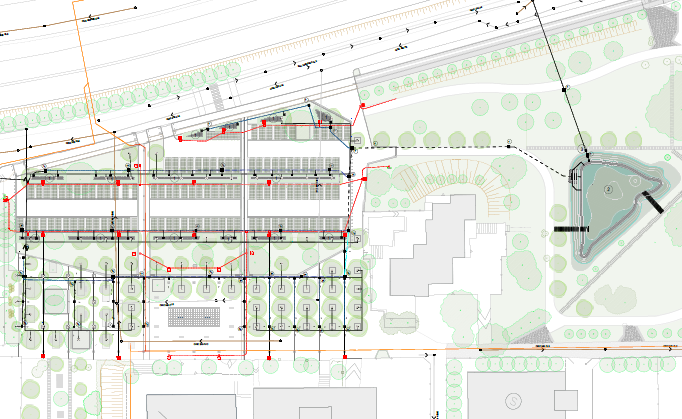
SuDS in Piazza Papa Giovanni XXIII and Giorgella Park in the municipality of Corsico (MI)
Chosen SuDS solution: Bioretention areas, permeable pavement, dry detention basins
Peculiarity: The project envisages the redevelopment of the square with the construction of a car park with permeable paving in the upper part, and a square with trees and a fountain in the lower part. Rainwater falling on the surface of the car park and the square will be managed through multi-objective SuDS elements such as bioretention areas and dry detention basins.
Year of design: Feasibility study 2022; Final and executive design 2023; Implementation in progress
The project involves the redevelopment of Piazza Papa Giovanni XXIII in the municipality of Corsico (MI), with the construction of a car park with permeable paving in the upper part, with bioretention areas in the flower beds between the parking stalls. Runoff from the square is instead conveyed to the storm drains where the new white water sewer will transport it to the detention basin, from where it can infiltrate into the ground through the drainage trench at the bottom.
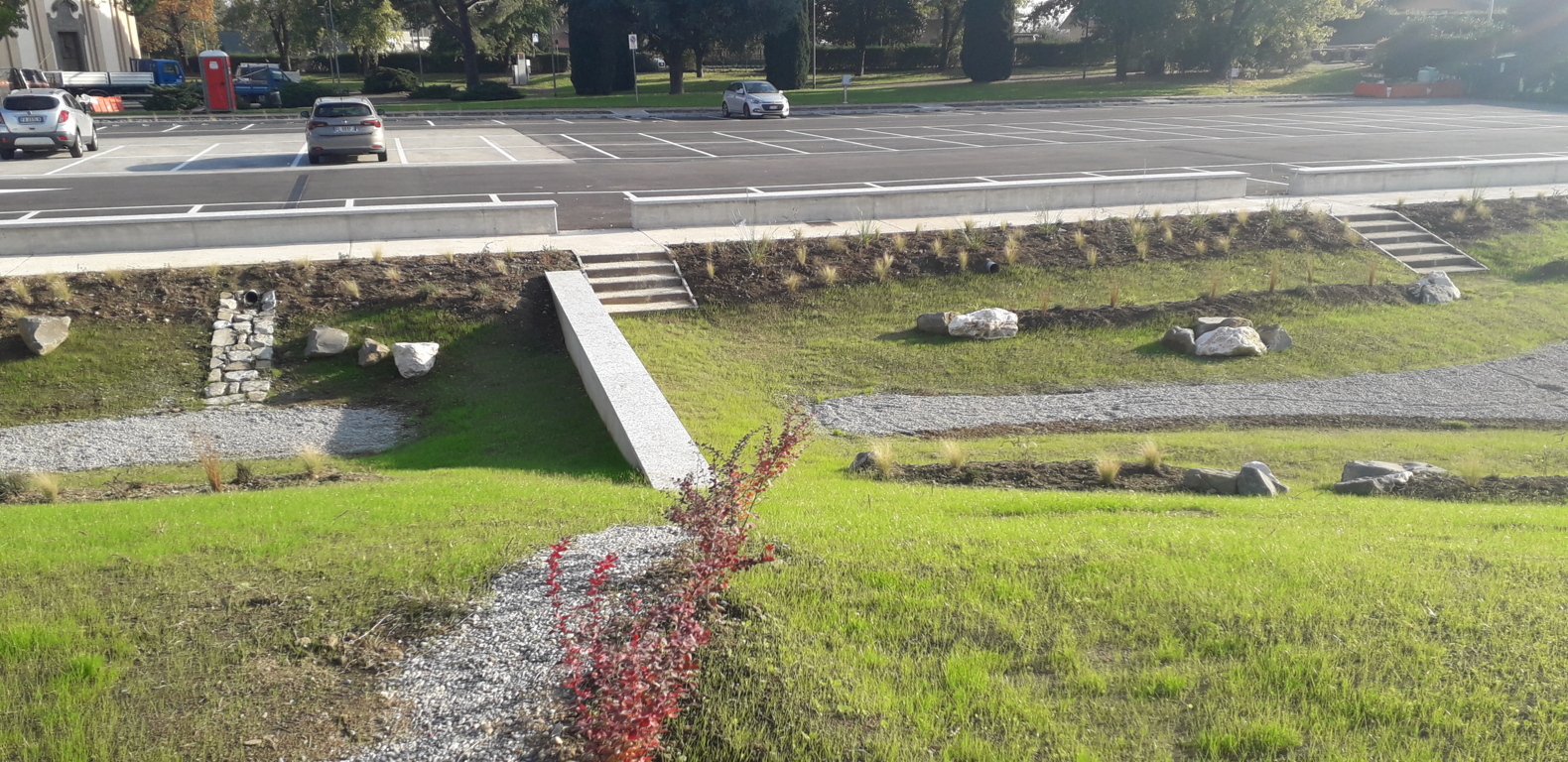
Desealing of municipal area in Via San Martino
Chosen SuDS solution: Bioretention areas, dry detention basins, infiltrating geocellular modules
Peculiarity: The project proposal is envisaged to be multi-objective in terms of hydraulic benefits, space and use, in order to make the urbanised area more permeable by reducing the risk of flooding and the formation of heat islands, also thanks to planting measures
Year of design: FTE 2022; Final and executive design 2023; Implementation in progress
The Carvico project concerns two de-sealing works to ensure rainwater drainage. In particular, the first intervention concerns the construction of new drains and new sections of white sewer system to drain rainwater from a part of the car park to the area of the new urban park, where a dry detention basin will be built, while for the other part of the car park the drained water will be conveyed to the bioretention area built along the south side of the car park.
The second intervention concerns the disconnection of the drains from the existing sewer system in the area of the forecourt in front of the church and the construction of bioretention areas for the collection and treatment of rainwater from the forecourt. It is also planned to construct infiltrating geocellular modules in the green area at the back of the forecourt.
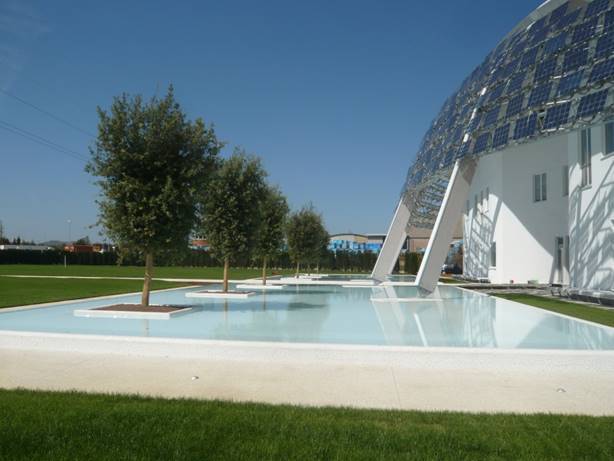
Kerakoll research centre, Sassuolo (MO - Italy)
Chosen SuDS solution: Open-water tanks
Peculiarity: Rainwater harvesting and landscaping
Year of realization: 2012

Kerakoll research centre, Sassuolo (MO - Italy)
Chosen SuDS solution: Bioretention system
Peculiarity: Nature-based solution sited in the proximity of a building of high aesthetic value
Year of realization: 2012

The Eco-Boulevard and the Water Arena for the Lazzaretto quartier, Bologna (BO - Italy)
Chosen SuDS solution: Swales, bioretention systems, urban detention basin
Peculiarity: IRIDRA's proposal for the Climate Change Adaptation of the Bologna Municipality, included in the technical assistance given to Atkins in the study "Climate Change Adaptation and Resilient Cities" (financed by the European Investment Bank -EIB). These proposal were included in the new guidelines of Bologna Municipality for SuDS systems, one of the action of the Bologna Climate Change Adaptation Plan developed under the BlueAP LIFE project
Year of the study: 2017

Sustainable drainage systems in Sesto Ulteriano (Metropolitan City of Milan - Italy)
Chosen SuDS solution: Bioretention systems, urban detention basins
Peculiarity: IRIDRA SRL design proposals in the feasibility study jointed with Majone and Partners Engineering Studio Gioia Gibelli, and Studio Idrotecnico for SuDS retrofitting of an industrial and urban catchment in Sesto Ulteriano, including retrofitting intervents along roads, parking lots and industrial sites. A study financed by PoliS Lombardia.
Year of the study: 2018

Retrofitting SuDS of BEN-ESSERE quartier, Bresso (Metropolitan City of Milan - Italy )
Chosen SuDS solution: Bioretention systems, wet swales, dry detention basins in urban park area
Peculiarity: Within the framework of urban desealing interventions with SuDS, it was taken the chance to design multipurpose elements able to also provide urban restoration of the BEN-ESSERE (wellness) quartier of Bresso. The design followed a "Water Sensitive" approach, infiltrating road runoff, and conveying road runoff overflow and roof runoff by a swale towards a detention basin within the urban park "Parco Nord", where volume control strategy according to local legislation (Reg. RL 07/2017) is provided.
Year of design: Preliminary design, 2021
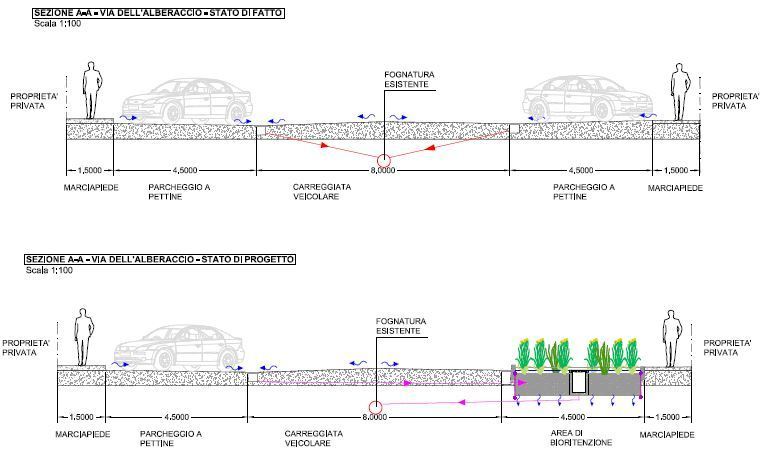
Nature-based solutions for urban flood mitigation in the San Paolo quartier, Prato (PO - Italy)
Chosen SuDS solution: Bioretention systems, dry detention basins , constructed wetlands for CSO
Peculiarity: Feasibility study for the study of potential NBS to reduce pluvial flooding of San Paolo quartier. Both "before-pipe" and "end-of-pipe" NBS solutions have been investigated, proposing different implementation scenario coupled with typological examples of the proposed NBS
Year of the study: 2021
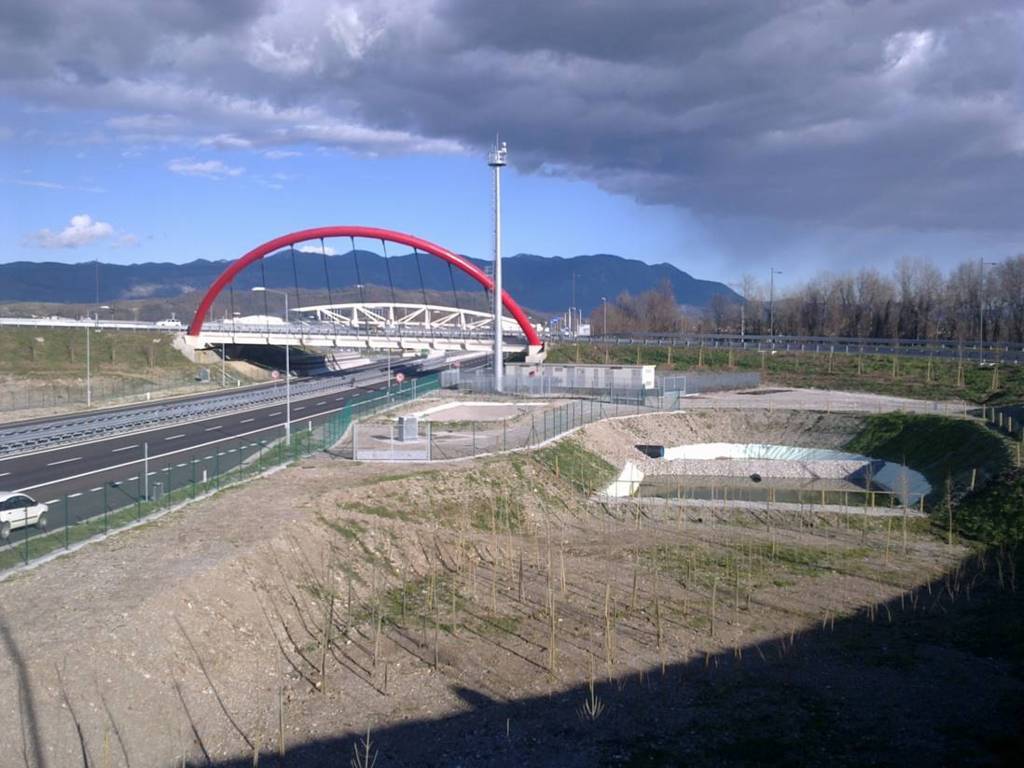
Villese-Gorizie highway, Veneto Region (Italy)
Chosen SuDS solution: Off-line treatment: First flush tank + HF + FWS + Detention and infiltration basin
On-line: HF/VF
Peculiarity: Multipurpose nature-based solution: environmental impact mitigation, landscaping improvement of highway. Designed by IRIDRA for Autovie Venete
Year of realization: 2015
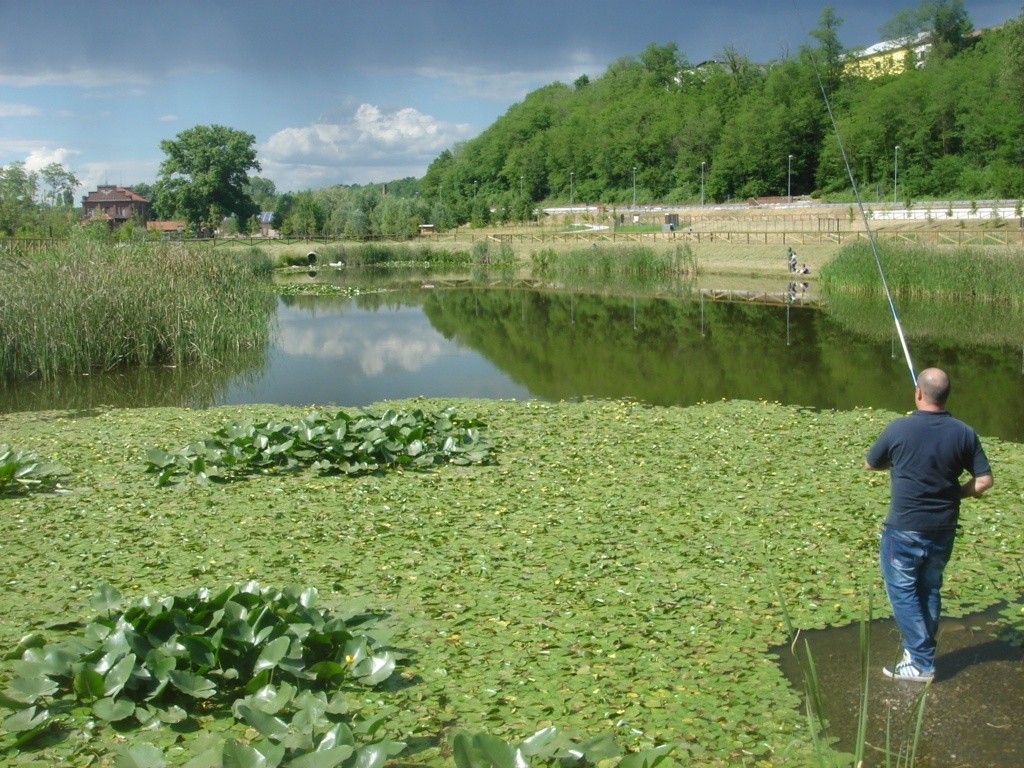
Combined sewer overflow of Gorla Maggiore (VA - Italy): The "Water Park"
Yearly treated volumes of first flush: 150.000 m3/year
Chosen SuDS solution: VF + FWS
Peculiarity: Multipurpose nature-based solution integrating different ecosystem services within the new "Water Park" of Gorla Maggiore: water quality improvement of Olona river, flood mitigation, recreational site, and biodiversity increase. Case study of EU funded project OpenNESS.
Year of realization: 2012

Park of Santa Domenica Valley in Ragusa (RG - Italy)
Chosen SuDS solution: Circular aerated wetland
Peculiarity: Nature-based solution included in the intervention of the urban restoration of the urban park of Santa Domenica Valley, in the Ragusa historical centre
Year of realization: 2018

Santa Chiara Open Lab in Trento (TN - Italy)
Chosen SuDS solution: Urban wetland
Peculiarity: Nature-based solution included in the intervention for the Santa Chiara Open Lab project, financed by Italian fund for suburbs restoration ("Bando Periferie"). The wetland receives the runoff from roofs and is designed as a multipurpuse intervention: treatment and reuse (gardening) of rainwater; flood mitigation; biodiversity increase in urban environment; aesthetic.
Year of design: 2018
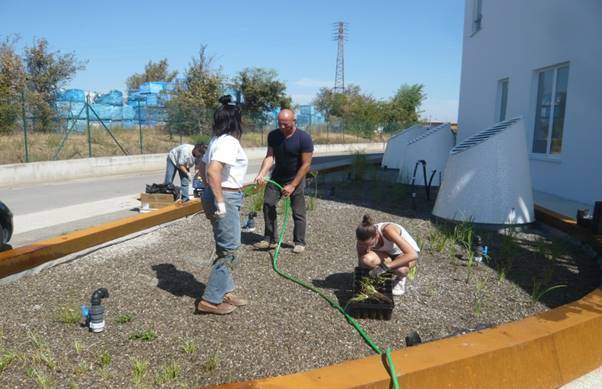
Kerakoll research centre, Sassuolo (MO - Italy)
Chosen SuDS solution: Rain garden
Peculiarity: Nature-based solution sited in proximity of a building of high aestethic value
Year of realization: 2012

Residential area in Preganziol (TV - Italy)
Chosen SuDS solution: Rain Garden
Year of realization : 2009
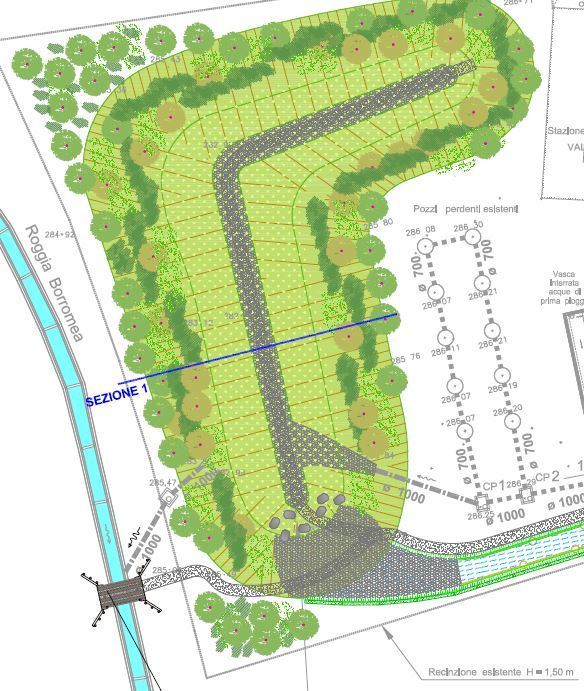
Restoration of Roggia Borromeo in Sant'Isidoro, Carugo (CO - Italy)
Chosen SuDS solution: Dry swale, Dry detention basin
Peculiarity: Multipurpose nature-based solution integrating different ecosystem services: water quality improvement, flood mitigation, recreational site, and biodiversity increase.
Year of design: 2016

